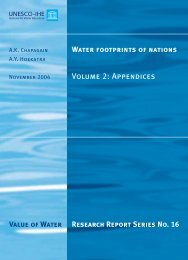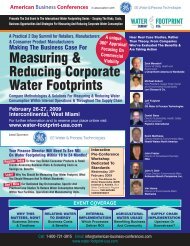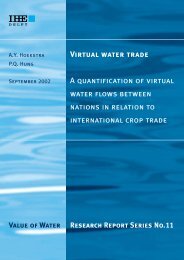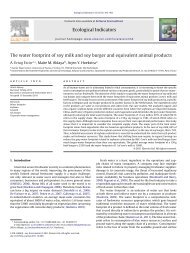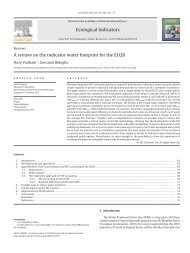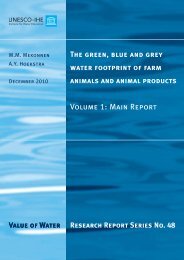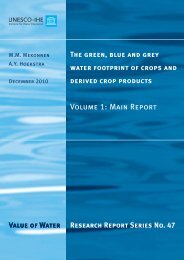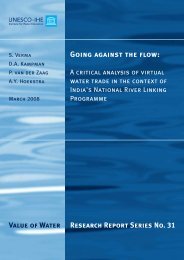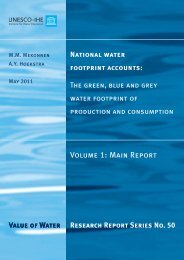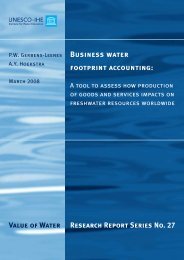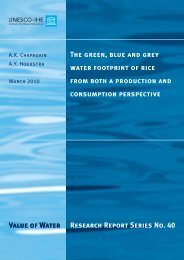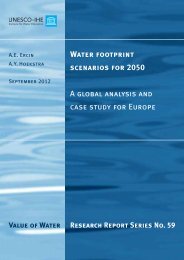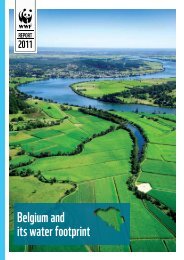The water needed to have the Dutch drink coffee - Water Footprint ...
The water needed to have the Dutch drink coffee - Water Footprint ...
The water needed to have the Dutch drink coffee - Water Footprint ...
- No tags were found...
You also want an ePaper? Increase the reach of your titles
YUMPU automatically turns print PDFs into web optimized ePapers that Google loves.
A.K. ChapagainA.Y. Hoekstra<strong>The</strong> <strong>water</strong> <strong>needed</strong> <strong>to</strong> <strong>have</strong><strong>the</strong> <strong>Dutch</strong> <strong>drink</strong> <strong>coffee</strong>August 2003Value of <strong>Water</strong>Research Report Series No. 14
<strong>The</strong> <strong>water</strong> <strong>needed</strong> <strong>to</strong> <strong>have</strong><strong>the</strong> <strong>Dutch</strong> <strong>drink</strong> <strong>coffee</strong>A.K. ChapagainA.Y. HoekstraAugust 2003Value of <strong>Water</strong> Research Report Series No. 14UNESCO-IHEP.O. Box 30152601 DA Delft<strong>The</strong> Ne<strong>the</strong>rlandsContact author:Arjen HoekstraPhone +31 15 215 18 28E-mail arjen@ihe.nl
Value of <strong>Water</strong> Research Report Series1. Exploring methods <strong>to</strong> assess <strong>the</strong> value of <strong>water</strong>: A case study on <strong>the</strong> Zambezi basin.A.K. Chapagain February 20002. <strong>Water</strong> value flows: A case study on <strong>the</strong> Zambezi basin.A.Y. Hoekstra, H.H.G. Savenije and A.K. Chapagain March 20003. <strong>The</strong> <strong>water</strong> value-flow concept.I.M. Seyam and A.Y. Hoekstra December 20004. <strong>The</strong> value of irrigation <strong>water</strong> in Nyanyadzi smallholder irrigation scheme, Zimbabwe.G.T. Pazvakawambwa and P. van der Zaag – January 20015. <strong>The</strong> economic valuation of <strong>water</strong>: Principles and methodsJ.I. Agudelo – August 20016. <strong>The</strong> economic valuation of <strong>water</strong> for agriculture: A simple method applied <strong>to</strong> <strong>the</strong> eight Zambezi basin countriesJ.I. Agudelo and A.Y. Hoekstra – August 20017. <strong>The</strong> value of fresh<strong>water</strong> wetlands in <strong>the</strong> Zambezi basinI.M. Seyam, A.Y. Hoekstra, G.S. Ngabirano and H.H.G. Savenije – August 20018. ‘Demand management’ and ‘<strong>Water</strong> as an economic good’: Paradigms with pitfallsH.H.G. Savenije and P. van der Zaag – Oc<strong>to</strong>ber 20019. Why <strong>water</strong> is not an ordinary economic goodH.H.G. Savenije – Oc<strong>to</strong>ber 200110. Calculation methods <strong>to</strong> assess <strong>the</strong> value of upstream <strong>water</strong> flows and s<strong>to</strong>rage as a function of downstream benefitsI.M. Seyam, A.Y. Hoekstra and H.H.G. Savenije – Oc<strong>to</strong>ber 200111. Virtual <strong>water</strong> trade: A quantification of virtual <strong>water</strong> flows between nations in relation <strong>to</strong> international crop tradeA.Y. Hoekstra and P.Q. Hung – September 200212. Virtual <strong>water</strong> trade: Proceedings of <strong>the</strong> International Expert Meeting on Virtual <strong>Water</strong> Trade, IHE Delft, <strong>The</strong>Ne<strong>the</strong>rlands, 12-13 December 2002A.Y. Hoekstra (edi<strong>to</strong>r) – February 200313.Virtual <strong>water</strong> flows between nations in relation <strong>to</strong> trade in lives<strong>to</strong>ck and lives<strong>to</strong>ck productsA.K. Chapagain and A.Y. Hoekstra – August 200314. <strong>The</strong> <strong>water</strong> <strong>needed</strong> <strong>to</strong> <strong>have</strong> <strong>the</strong> <strong>Dutch</strong> <strong>drink</strong> <strong>coffee</strong>A.K. Chapagain and A.Y. Hoekstra – August 200315. <strong>The</strong> <strong>water</strong> <strong>needed</strong> <strong>to</strong> <strong>have</strong> <strong>the</strong> <strong>Dutch</strong> <strong>drink</strong> teaA.K. Chapagain and A.Y. Hoekstra – August 2003AcknowledgmentThis report is <strong>the</strong> result of a specific question that came from Novib, <strong>The</strong> Ne<strong>the</strong>rlands. <strong>The</strong> work is used as abackground document <strong>to</strong> <strong>the</strong> presentation materials prepared by Novib for <strong>the</strong> VARA Vroege Vogels Festival inBerg en Bos, Apeldoorn, 28 September 2003, which is organised on <strong>the</strong> occasion of <strong>the</strong> 25-year existence of <strong>the</strong>VARA Vroege Vogels radio programme. We would like <strong>to</strong> thank Novib for <strong>the</strong>ir financial support. We also thank<strong>the</strong> <strong>Dutch</strong> National Institute for Public Health and <strong>the</strong> Environment (RIVM), which provides basic funding for<strong>the</strong> UNESCO-IHE research programme on Virtual <strong>Water</strong> and <strong>Water</strong> <strong>Footprint</strong>s.
ContentsSummary................................................................................................................................................51. Introduction ....................................................................................................................................71.1. <strong>The</strong> ‘virtual <strong>water</strong>’ content of <strong>coffee</strong>: How much <strong>water</strong> is <strong>needed</strong> <strong>to</strong> produce <strong>coffee</strong>? ..........................71.2. Objectives of <strong>the</strong> study ...........................................................................................................................72. Method ............................................................................................................................................92.1. Stages in <strong>coffee</strong> production.....................................................................................................................92.2. Calculating <strong>the</strong> <strong>water</strong> required in <strong>the</strong> different production stages of <strong>coffee</strong> .........................................122.3. Calculating import and export of virtual <strong>water</strong> in<strong>to</strong> and from <strong>the</strong> Ne<strong>the</strong>rlands as a result of <strong>coffee</strong> trade........123. Data sources ................................................................................................................................153.1. Climate data and crop parameters.........................................................................................................153.2. Coffee yields.........................................................................................................................................153.3. Coffee trade ..........................................................................................................................................153.4. Production fac<strong>to</strong>rs.................................................................................................................................163.5. <strong>Water</strong> requirements in <strong>the</strong> wet production method...............................................................................164. Virtual <strong>water</strong> content of <strong>coffee</strong> per producing country............................................................175. <strong>The</strong> <strong>to</strong>tal volume of <strong>water</strong> <strong>needed</strong> <strong>to</strong> <strong>have</strong> <strong>the</strong> <strong>Dutch</strong> <strong>drink</strong> <strong>coffee</strong>.........................................195.1. Virtual <strong>water</strong> import related <strong>to</strong> <strong>coffee</strong> import .......................................................................................195.2. Virtual <strong>water</strong> export related <strong>to</strong> <strong>coffee</strong> export........................................................................................195.3. Net virtual <strong>water</strong> import related <strong>to</strong> <strong>coffee</strong> trade....................................................................................206. <strong>The</strong> <strong>water</strong> <strong>needed</strong> <strong>to</strong> <strong>drink</strong> one cup of <strong>coffee</strong> ...........................................................................217. Conclusion ...................................................................................................................................23References...........................................................................................................................................25AppendicesI. Green <strong>coffee</strong> production by country (1995-99).II. Virtual <strong>water</strong> content of <strong>coffee</strong> produced with <strong>the</strong> wet production method by country of origin.III. Virtual <strong>water</strong> content of <strong>coffee</strong> produced with <strong>the</strong> dry production method by country of origin.IV. Average annual virtual <strong>water</strong> import <strong>to</strong> <strong>the</strong> Ne<strong>the</strong>rlands related <strong>to</strong> <strong>coffee</strong> import in <strong>the</strong> period 1995-99.V. Average annual virtual <strong>water</strong> export from <strong>the</strong> Ne<strong>the</strong>rlands related <strong>to</strong> <strong>coffee</strong> export in <strong>the</strong> period 1995-99.
SummaryCoffee is, in dollar terms, <strong>the</strong> most important agricultural product traded in <strong>the</strong> world. Producing <strong>coffee</strong> requiresa lot of <strong>water</strong>, but at <strong>the</strong> start of this study no specific studies were available. <strong>The</strong> objective of this study is <strong>to</strong>calculate <strong>the</strong> volumes of <strong>water</strong> required <strong>to</strong> <strong>drink</strong> <strong>coffee</strong> in <strong>the</strong> Ne<strong>the</strong>rlands, with <strong>the</strong> underlying aim <strong>to</strong> contribute<strong>to</strong> figures that can be used for raising awareness on <strong>the</strong> effects of our consumption pattern on <strong>the</strong> use of naturalresources.We <strong>have</strong> specifically looked at <strong>the</strong> sources of <strong>the</strong> <strong>Dutch</strong> <strong>coffee</strong>, because <strong>the</strong> <strong>water</strong> requirements per kilogram of<strong>coffee</strong> differ in <strong>the</strong> various <strong>coffee</strong>-producing countries. <strong>The</strong> ‘virtual <strong>water</strong> content’ of <strong>coffee</strong> has been defined as<strong>the</strong> <strong>to</strong>tal volume of <strong>water</strong> required for producing <strong>the</strong> <strong>coffee</strong>. In order <strong>to</strong> calculate <strong>the</strong> <strong>to</strong>tal virtual <strong>water</strong> conten<strong>to</strong>f roasted <strong>coffee</strong> we <strong>have</strong> looked in<strong>to</strong> <strong>the</strong> <strong>water</strong> requirements in each production stage. We <strong>have</strong> calculated <strong>the</strong><strong>water</strong> requirements in both <strong>the</strong> wet and <strong>the</strong> dry production method. For calculating <strong>the</strong> crop <strong>water</strong> requirementsof <strong>the</strong> <strong>coffee</strong> plant we <strong>have</strong> used data and models of <strong>the</strong> Food and Agriculture Organization. Data for <strong>the</strong>different stages of <strong>the</strong> post-harvesting production process <strong>have</strong> been taken from various sources. Data oninternational <strong>coffee</strong> trade <strong>have</strong> been taken from <strong>the</strong> United Nations Statistics Division.We found that for <strong>drink</strong>ing one standard cup of <strong>coffee</strong> in <strong>the</strong> Ne<strong>the</strong>rlands we need about 140 litres of <strong>water</strong>, byfar <strong>the</strong> largest part for growing <strong>the</strong> <strong>coffee</strong> plant. A standard cup of <strong>coffee</strong> is 125 ml, which means that we needmore than 1100 drops of <strong>water</strong> for producing one drop of <strong>coffee</strong>. This figure calculated for <strong>the</strong> <strong>Dutch</strong> situationhappens <strong>to</strong> be quite representative as a global average. Total <strong>coffee</strong> consumption in <strong>the</strong> Ne<strong>the</strong>rlands requires a<strong>to</strong>tal of 2.6 billion cubic metres of <strong>water</strong> per year, which is equal <strong>to</strong> 36% of <strong>the</strong> annual Meuse flow. <strong>The</strong> <strong>Dutch</strong>people account for 2.4% of <strong>the</strong> world <strong>coffee</strong> consumption. All <strong>to</strong>ge<strong>the</strong>r, <strong>the</strong> world population requires about 110billion cubic metres of <strong>water</strong> per year in order <strong>to</strong> be able <strong>to</strong> <strong>drink</strong> <strong>coffee</strong>. This is equivalent <strong>to</strong> 15 times <strong>the</strong>annual Meuse runoff, or 1.5 times <strong>the</strong> annual Rhine runoff.<strong>The</strong> <strong>water</strong> <strong>needed</strong> <strong>to</strong> <strong>drink</strong> <strong>coffee</strong> in <strong>the</strong> Ne<strong>the</strong>rlands is actually not <strong>Dutch</strong> <strong>water</strong>, because <strong>the</strong> <strong>coffee</strong> is producedin Latin America, Africa and Asia. <strong>The</strong> most important sources are Brazil and Colombia. <strong>The</strong>re is also a largeamount of <strong>coffee</strong> imported from transit-countries, particularly Belgium and Germany.<strong>The</strong> <strong>water</strong> <strong>needed</strong> <strong>to</strong> make <strong>coffee</strong> depends on <strong>the</strong> climate at <strong>the</strong> place of production and <strong>the</strong> yields per hectarethat are obtained. For <strong>the</strong> overall <strong>water</strong> need, it makes hardly any difference whe<strong>the</strong>r <strong>the</strong> dry or wet productionprocess is applied, because <strong>the</strong> <strong>water</strong> used in <strong>the</strong> wet production process is a very small fraction (0.34%) of <strong>the</strong><strong>water</strong> used <strong>to</strong> grow <strong>the</strong> <strong>coffee</strong> plant. However, this relatively small amount of <strong>water</strong> is often a problem, becausethis is <strong>water</strong> <strong>to</strong> be obtained from surface <strong>water</strong>, which is sometimes scarcely available. Besides, <strong>the</strong> waste<strong>water</strong>from <strong>the</strong> <strong>coffee</strong> fac<strong>to</strong>ries is often heavily polluted. <strong>The</strong> large volume of <strong>water</strong> <strong>to</strong> grow <strong>the</strong> <strong>coffee</strong> plant comesfrom rain<strong>water</strong>, a source with less competition between alternative uses than in <strong>the</strong> case of surface <strong>water</strong>.Drinking tea instead of <strong>coffee</strong> would save a lot of <strong>water</strong>. For a standard cup of tea of 250 ml we require 34 litreof <strong>water</strong>. This means that tea requires about eight times less <strong>water</strong> than <strong>coffee</strong>.
<strong>The</strong> <strong>water</strong> <strong>needed</strong> <strong>to</strong> <strong>have</strong> <strong>the</strong> <strong>Dutch</strong> <strong>drink</strong> <strong>coffee</strong> / 71. Introduction1.1. <strong>The</strong> ‘virtual <strong>water</strong>’ content of <strong>coffee</strong>: How much <strong>water</strong> is <strong>needed</strong> <strong>to</strong> produce <strong>coffee</strong>?<strong>The</strong> roots of <strong>coffee</strong> consumption are probably in Ethiopia. <strong>The</strong> <strong>coffee</strong> tree is said <strong>to</strong> originate in <strong>the</strong> province ofKaffa (ICO, 2003). Coffee spread <strong>to</strong> <strong>the</strong> different parts of <strong>the</strong> world in <strong>the</strong> 17 th and 18 th century, <strong>the</strong> period ofcolonisation. Early 18 th century <strong>the</strong> <strong>Dutch</strong> colonies had become <strong>the</strong> main suppliers of <strong>coffee</strong> <strong>to</strong> Europe. Todaypeople <strong>drink</strong> <strong>coffee</strong> all over <strong>the</strong> world. <strong>The</strong> importance of <strong>coffee</strong> <strong>to</strong> people cannot easily be overestimated.Coffee is of great economic importance <strong>to</strong> <strong>the</strong> producing, mostly developing countries and of considerablesocial importance <strong>to</strong> <strong>the</strong> consuming countries. Coffee is, in dollar terms, <strong>the</strong> most important agricultural producttraded in <strong>the</strong> world (Dubois, 2001).Coffee consumption is possible through <strong>the</strong> use of natural and human resources in <strong>the</strong> producing countries. Oneof <strong>the</strong> natural resources required <strong>to</strong> make <strong>coffee</strong> is <strong>water</strong>. <strong>The</strong>re is a particular <strong>water</strong> need for growing <strong>the</strong> <strong>coffee</strong>plant, but <strong>the</strong>re is also a need for <strong>water</strong> <strong>to</strong> process <strong>coffee</strong> cherries in<strong>to</strong> <strong>the</strong> final product.For expressing <strong>the</strong> <strong>to</strong>tal volume of <strong>water</strong> <strong>needed</strong> <strong>to</strong> produce a good, Allan has proposed <strong>the</strong> concept of ‘virtual<strong>water</strong>’ (Allan, 1993; 1994). <strong>The</strong> virtual <strong>water</strong> content of a commodity or service is defined as <strong>the</strong> volume of<strong>water</strong> required <strong>to</strong> produce this commodity or service (Allan, 1998, 1999; Hoekstra, 1998). When <strong>the</strong>re is atransfer of a product from one place <strong>to</strong> ano<strong>the</strong>r, <strong>the</strong>re is little direct physical transfer of <strong>water</strong> (apart from <strong>the</strong><strong>water</strong> content of <strong>the</strong> product, which is quite insignificant in terms of volume). <strong>The</strong>re is however a significanttransfer of virtual <strong>water</strong>. In this way <strong>the</strong> <strong>coffee</strong> producing countries export immense volumes of ‘virtual <strong>water</strong>’<strong>to</strong> <strong>the</strong> large <strong>coffee</strong> consuming countries. Import of virtual <strong>water</strong> in<strong>to</strong> <strong>the</strong> consuming countries means that <strong>the</strong>secountries indirectly employ <strong>the</strong> <strong>water</strong> in <strong>the</strong> producing countries. Due <strong>to</strong> <strong>the</strong> fact that <strong>the</strong> production of <strong>coffee</strong> formany people in <strong>the</strong> world – certainly for <strong>the</strong> <strong>Dutch</strong> people – is in a country far off, most people <strong>have</strong> little ideaof <strong>the</strong> resources <strong>needed</strong> <strong>to</strong> enable <strong>the</strong>m <strong>to</strong> consume. This study is meant <strong>to</strong> assess <strong>the</strong> volume of <strong>water</strong> <strong>needed</strong> <strong>to</strong><strong>have</strong> <strong>the</strong> <strong>Dutch</strong> <strong>drink</strong> <strong>coffee</strong>, in order <strong>to</strong> <strong>have</strong> concrete figures for creating awareness.1.2. Objectives of <strong>the</strong> studyThis study has three specific objectives:1. To estimate <strong>the</strong> virtual <strong>water</strong> content of <strong>coffee</strong> imported <strong>to</strong> <strong>the</strong> Ne<strong>the</strong>rlands, distinguishing between <strong>the</strong>different sources of <strong>the</strong> <strong>coffee</strong>.2. To quantify <strong>the</strong> volumes of virtual <strong>water</strong> trade inflows in<strong>to</strong> and outflows from <strong>the</strong> Ne<strong>the</strong>rlands in <strong>the</strong> period1995-99 insofar as <strong>the</strong>y are related <strong>to</strong> <strong>coffee</strong> trade.3. To assess <strong>the</strong> volume of <strong>water</strong> <strong>needed</strong> <strong>to</strong> <strong>drink</strong> one cup of <strong>coffee</strong> in <strong>the</strong> Ne<strong>the</strong>rlands.
<strong>The</strong> <strong>water</strong> <strong>needed</strong> <strong>to</strong> <strong>have</strong> <strong>the</strong> <strong>Dutch</strong> <strong>drink</strong> <strong>coffee</strong> / 92. Method2.1. Stages in <strong>coffee</strong> productionAfter plantation it takes about 3 <strong>to</strong> 5 years before <strong>the</strong> <strong>coffee</strong> plants give yield. <strong>The</strong> plant reaches its optimumyield between <strong>the</strong> sixth and tenth year of life and <strong>the</strong>n gradually diminishes until its fifteenth year, s<strong>to</strong>ppingal<strong>to</strong>ge<strong>the</strong>r after 40 years (CPC, 2003).<strong>The</strong>re are two major varieties of <strong>coffee</strong>: Arabica and Robusta (ICO, 2003). <strong>The</strong> Arabica plant, Coffea Arabica,is a plant growing at high altitudes, between 800 and 2000 metres, and supplies about 75 per cent of <strong>the</strong> world<strong>coffee</strong>. Arabica <strong>coffee</strong> is grown throughout Latin America, in Central and East Africa, in India and <strong>to</strong> someextent in Indonesia. <strong>The</strong> Arabica plant is generally a large bush with dark-green oval leaves. <strong>The</strong> fruits are ovaland mature in 7 <strong>to</strong> 9 months. <strong>The</strong> fruits usually contain two seeds, <strong>the</strong> <strong>coffee</strong> beans, but sometimes <strong>the</strong>re is jus<strong>to</strong>ne seed.Robusta <strong>coffee</strong> comes from <strong>the</strong> Coffea Canephora, a plant cultivated from sea level up <strong>to</strong> 600 metres, mainly inWest and Central Africa, throughout South-East Asia and <strong>to</strong> some extent in Brazil. Robusta <strong>coffee</strong> accounts forabout 25 per cent of <strong>the</strong> world <strong>coffee</strong> production. <strong>The</strong> Robusta plant is a robust shrub or small tree growing up<strong>to</strong> 10 metres in height, but with a shallow root system. <strong>The</strong> fruits are rounded and take up <strong>to</strong> 11 months <strong>to</strong>mature; <strong>the</strong> seeds are oval in shape, brownish-yellow in appearance and smaller than those of Coffea Arabica. Ifcompared with Arabica <strong>coffee</strong>, Robusta <strong>coffee</strong> is generally considered of inferior quality.Figure 2.1 shows <strong>the</strong> major areas of <strong>coffee</strong> production in <strong>the</strong> world. <strong>The</strong> annual production of <strong>coffee</strong> per countryduring <strong>the</strong> period 1995-99 is presented in Appendix I.Figure 2.1. Coffee production in <strong>the</strong> world (source: FNC, 1996).
10 / <strong>The</strong> <strong>water</strong> <strong>needed</strong> <strong>to</strong> <strong>have</strong> <strong>the</strong> <strong>Dutch</strong> <strong>drink</strong> <strong>coffee</strong><strong>The</strong> <strong>coffee</strong> bean is <strong>the</strong> seed of <strong>the</strong> <strong>coffee</strong> tree. <strong>The</strong> fruits of <strong>the</strong> <strong>coffee</strong> tree, with <strong>the</strong> beans inside, are green atfirst and become red orange at maturity. <strong>The</strong> fruits are called cherries due <strong>to</strong> <strong>the</strong>ir colour, shape and size. Asshown in schematised form in Figure 2.2, <strong>the</strong> <strong>coffee</strong> seeds are inside <strong>the</strong> cherry in <strong>the</strong> form of two beans coupledat <strong>the</strong>ir flat surface. <strong>The</strong> beans are covered by a thin membrane or coat. This membrane or seed skin(spermoderm), is referred <strong>to</strong> in <strong>the</strong> <strong>coffee</strong> trade as <strong>the</strong> ‘silver skin’. Each of <strong>the</strong>se coated beans is surrounded bya kind of parchment layer (endocarp or pergamino), very resistant, and golden yellow. <strong>The</strong> beans withparchment layer are embedded in a layer of sugary mucilaginous fleshy pulp (mesocarp). <strong>The</strong> outer layer of acherry is formed by a thin film, <strong>the</strong> skin (epicarp or esocarpo).Figure 2.2. <strong>The</strong> components of a <strong>coffee</strong> cherry.Before <strong>the</strong> seeds of <strong>the</strong> <strong>coffee</strong> plant result in a cup of <strong>coffee</strong>, <strong>the</strong>re are a number of steps. First, <strong>the</strong> <strong>coffee</strong>cherries are harvested. Second, <strong>the</strong> cherries are processed in<strong>to</strong> so-called ‘green <strong>coffee</strong>’. <strong>The</strong>re are basically twoprocesses <strong>to</strong> process fresh cherries in<strong>to</strong> green <strong>coffee</strong>: <strong>the</strong> dry and <strong>the</strong> wet method, which will be discussedbelow. <strong>The</strong> green <strong>coffee</strong> is processed in<strong>to</strong> roasted <strong>coffee</strong> through roasting, a heat treatment process <strong>to</strong> transform<strong>the</strong> green beans in<strong>to</strong> <strong>the</strong> aromatic brown <strong>coffee</strong> we all know. <strong>The</strong> roasted <strong>coffee</strong> is <strong>the</strong> ingredient for making acup of <strong>coffee</strong>. Both green <strong>coffee</strong> and roasted <strong>coffee</strong> are internationally traded. <strong>The</strong> different stages in postharvestprocessing of <strong>coffee</strong> beans are shown in Figure 2.3.<strong>The</strong> dry method, also called <strong>the</strong> natural method, is <strong>the</strong> simplest, cheapest and most traditional method ofprocessing <strong>coffee</strong>. <strong>The</strong> first step of processing is <strong>to</strong> dry <strong>the</strong> cherries, normally in direct sunlight <strong>to</strong> reduce <strong>the</strong>moisture content <strong>to</strong> <strong>the</strong> optimum of 12.5 per cent. <strong>The</strong> second step is hulling of <strong>the</strong> dried cherries, which meansthat <strong>the</strong> whole of <strong>the</strong> dried outer coverings of <strong>the</strong> original cherries (including <strong>the</strong> pulp and <strong>the</strong> parchment layer)are removed, leaving <strong>the</strong> <strong>coffee</strong> beans with some silver skin remainders. During <strong>the</strong> next step, any silver skinthat remains on <strong>the</strong> beans after hulling is removed in a polishing machine. Polishing beans is an optional processthat is not always done. Although <strong>coffee</strong> beans are of a fairly uniform size and proportion, <strong>the</strong>y are graded firstby size and <strong>the</strong>n by density. Unhulled beans are removed. <strong>The</strong> product after polishing, grading and sorting iscalled ‘green <strong>coffee</strong>’. <strong>The</strong> green <strong>coffee</strong> obtained through <strong>the</strong> dry method is sometimes referred <strong>to</strong> as ‘unwashed<strong>coffee</strong>’ or ‘natural <strong>coffee</strong>’. <strong>The</strong> dry method is used for about 95% of <strong>the</strong> Arabica <strong>coffee</strong> produced in Brazil, mos<strong>to</strong>f <strong>the</strong> <strong>coffee</strong>s produced in Ethiopia, Haiti and Paraguay, as well as for some Arabicas produced in India andEcuador. Almost all Robustas are processed through this method (ICO, 2003).
<strong>The</strong> <strong>water</strong> <strong>needed</strong> <strong>to</strong> <strong>have</strong> <strong>the</strong> <strong>Dutch</strong> <strong>drink</strong> <strong>coffee</strong> / 11<strong>The</strong> essential difference between <strong>the</strong> wet and <strong>the</strong> dry method is that in <strong>the</strong> wet method <strong>the</strong> pulp of <strong>the</strong> fruit isseparated from <strong>the</strong> beans before <strong>the</strong> drying stage. <strong>The</strong> first step in <strong>the</strong> wet method is washing <strong>the</strong> cherries <strong>to</strong>remove waste and <strong>the</strong>n pulping <strong>the</strong> cherries (removing <strong>the</strong> pulp) in a dépulpeuse machine, leaving two beanssurrounded with <strong>the</strong>ir parchment. <strong>The</strong> pulping generally leaves some residual flesh <strong>to</strong> <strong>the</strong> beans as well as <strong>the</strong>sticky mucilage adhering <strong>to</strong> <strong>the</strong> parchment surrounding <strong>the</strong> beans. In order <strong>to</strong> be able <strong>to</strong> remove residual pulpand mucilage, <strong>the</strong> beans are put in fermentation tanks, accelerating <strong>the</strong> process of destruction of <strong>the</strong> residualpulp and mucilage. After fermentation, <strong>the</strong> beans are washed, leaving so-called ‘wet parchment <strong>coffee</strong>’. Afterdrying this product one has ‘dry parchment <strong>coffee</strong>’. [If people briefly speak of ‘parchment <strong>coffee</strong>’ <strong>the</strong>y generallyrefer <strong>to</strong> dry parchment <strong>coffee</strong>.] Hulling is done <strong>to</strong> remove <strong>the</strong> dried parchment layer immediately surrounding<strong>the</strong> beans. <strong>The</strong> beans are <strong>the</strong>n sieved, polished and sorted out before being put in bags. <strong>The</strong> <strong>coffee</strong> at this stage is‘green <strong>coffee</strong>’, in <strong>the</strong> case of <strong>the</strong> wet production process also called ‘washed <strong>coffee</strong>’. <strong>The</strong> wet method isgenerally used for all <strong>the</strong> Arabica <strong>coffee</strong>s, with <strong>the</strong> exception of those produced in Brazil and <strong>the</strong> Arabicaproducingcountries mentioned above as users of <strong>the</strong> dry method. It is rarely used for Robustas.Wet production methodDry production methodCherryCherryPulpingPulped cherryWet parchment<strong>coffee</strong>Fermentation and washingDryingDryingDry parchment<strong>coffee</strong>Hulled beansHulling (removingparchment layer)Polishing and sortingDried cherryHulled beansHulling (removingpulp and parchment)Polishing and sortingGreen <strong>coffee</strong>RoastingGreen <strong>coffee</strong>RoastingRoasted <strong>coffee</strong>Roasted <strong>coffee</strong>Figure 2.3. Post-harvesting steps of <strong>coffee</strong> production: <strong>the</strong> dry and <strong>the</strong> wet method.
12 / <strong>The</strong> <strong>water</strong> <strong>needed</strong> <strong>to</strong> <strong>have</strong> <strong>the</strong> <strong>Dutch</strong> <strong>drink</strong> <strong>coffee</strong>2.2. Calculating <strong>the</strong> <strong>water</strong> required in <strong>the</strong> different production stages of <strong>coffee</strong><strong>The</strong> virtual <strong>water</strong> content of <strong>coffee</strong> is <strong>the</strong> volume of <strong>water</strong> required <strong>to</strong> produce one unit of <strong>coffee</strong>, generallyexpressed as cubic metre of <strong>water</strong> per <strong>to</strong>n of <strong>coffee</strong>. This is different at <strong>the</strong> different stages of <strong>coffee</strong> processing.First, <strong>the</strong> virtual <strong>water</strong> content of fresh cherries is calculated based on <strong>the</strong> crop <strong>water</strong> requirement of <strong>the</strong> <strong>coffee</strong>plant (in m 3 /ha) and <strong>the</strong> yield of fresh cherries (in <strong>to</strong>n/ha). After each processing step, <strong>the</strong> weight of <strong>the</strong>remaining product is smaller than <strong>the</strong> original weight. Following <strong>the</strong> methodology proposed by Chapagain andHoekstra (2003a) we define <strong>the</strong> ‘product fraction’ (pf) in a certain processing step as <strong>the</strong> ratio of <strong>the</strong> weight of<strong>the</strong> resulting product <strong>to</strong> <strong>the</strong> weight of <strong>the</strong> original product. <strong>The</strong> virtual <strong>water</strong> content of <strong>the</strong> resulting product(expressed in m 3 /<strong>to</strong>n) is larger than <strong>the</strong> virtual <strong>water</strong> content of <strong>the</strong> original product. It can be found by dividing<strong>the</strong> virtual <strong>water</strong> content of <strong>the</strong> original product by <strong>the</strong> product fraction. If a particular processing step requires<strong>water</strong> (viz. <strong>the</strong> processes of pulping, fermentation and washing in <strong>the</strong> wet production method), <strong>the</strong> <strong>water</strong> <strong>needed</strong>(in m 3 per <strong>to</strong>n of original product) is added <strong>to</strong> <strong>the</strong> initial virtual <strong>water</strong> content of <strong>the</strong> original product beforetranslating it in<strong>to</strong> a value for <strong>the</strong> virtual <strong>water</strong> content of <strong>the</strong> resulting product. Figure 2.4 shows how <strong>the</strong> virtual<strong>water</strong> content of <strong>coffee</strong> is calculated in its subsequent production stages in <strong>the</strong> case of <strong>the</strong> wet productionmethod. As an illustration of <strong>the</strong> calculation process, Tables 2.1 and 2.2 show examples for Brazil for <strong>the</strong> wetand <strong>the</strong> dry production method respectively. Appendices II and III include <strong>the</strong> calculations for all <strong>coffee</strong>producing countries from which <strong>the</strong> Ne<strong>the</strong>rlands imports <strong>coffee</strong>.2.3. Calculating import and export of virtual <strong>water</strong> in<strong>to</strong> and from <strong>the</strong> Ne<strong>the</strong>rlands as a result of <strong>coffee</strong> trade<strong>The</strong> volume of virtual <strong>water</strong> imported in<strong>to</strong> <strong>the</strong> Ne<strong>the</strong>rlands (in m 3 /yr) as a result of <strong>coffee</strong> import can be foundby multiplying <strong>the</strong> amount of <strong>coffee</strong> imported (in <strong>to</strong>n/yr) by <strong>the</strong> virtual <strong>water</strong> content of <strong>the</strong> <strong>coffee</strong> (in m 3 /<strong>to</strong>n).<strong>The</strong> latter depends on <strong>the</strong> form of <strong>the</strong> imported <strong>coffee</strong> (green or roasted <strong>coffee</strong>) and <strong>the</strong> origin of <strong>the</strong> <strong>coffee</strong>. <strong>The</strong>origin of <strong>the</strong> <strong>coffee</strong> is important because <strong>coffee</strong> production takes more <strong>water</strong> in some countries if compared <strong>to</strong>o<strong>the</strong>r countries.<strong>The</strong> volume of virtual <strong>water</strong> exported from <strong>the</strong> Ne<strong>the</strong>rlands is calculated by multiplying <strong>the</strong> export quantity by<strong>the</strong> average virtual <strong>water</strong> content of <strong>coffee</strong> in <strong>the</strong> Ne<strong>the</strong>rlands. <strong>The</strong> latter is taken as <strong>the</strong> average virtual <strong>water</strong>content of <strong>the</strong> <strong>coffee</strong> imported in<strong>to</strong> <strong>the</strong> Ne<strong>the</strong>rlands.<strong>The</strong> difference between <strong>the</strong> <strong>to</strong>tal virtual <strong>water</strong> import and <strong>the</strong> <strong>to</strong>tal virtual <strong>water</strong> export is <strong>the</strong> net virtual <strong>water</strong>import <strong>to</strong> <strong>the</strong> Ne<strong>the</strong>rlands, an indica<strong>to</strong>r for <strong>the</strong> <strong>to</strong>tal amount of <strong>water</strong> <strong>needed</strong> <strong>to</strong> <strong>have</strong> <strong>the</strong> <strong>Dutch</strong> <strong>drink</strong> <strong>coffee</strong>.
<strong>The</strong> <strong>water</strong> <strong>needed</strong> <strong>to</strong> <strong>have</strong> <strong>the</strong> <strong>Dutch</strong> <strong>drink</strong> <strong>coffee</strong> / 13Climatic parameters (CLIMWAT)CROPWATCrop <strong>water</strong> requirement[m 3 /ha]Fresh cherry yield[<strong>to</strong>n/ha]Virtual <strong>water</strong> content of cherry[m 3 /<strong>to</strong>n]<strong>Water</strong> use for pulping[m 3 /<strong>to</strong>n of fresh cherry]Product fraction in pulping process[<strong>to</strong>n of pulped cherry / <strong>to</strong>n of fresh cherry]Virtual <strong>water</strong> content of pulped cherry[m 3 /<strong>to</strong>n]<strong>Water</strong> used for soaking and washing[m 3 /<strong>to</strong>n of pulped cherry]Product fraction in fermentation process[<strong>to</strong>n of wet parchment <strong>coffee</strong> / <strong>to</strong>n of pulped cherry]Virtual <strong>water</strong> content ofwet parchment <strong>coffee</strong> [m 3 /<strong>to</strong>n]Product fraction in drying process[<strong>to</strong>n of dry per <strong>to</strong>n of wet parchment <strong>coffee</strong>]Virtual <strong>water</strong> content ofdry parchment <strong>coffee</strong> [m 3 /<strong>to</strong>n]Product fraction in hulling process[<strong>to</strong>n of hulled beans / <strong>to</strong>n of dry parchment <strong>coffee</strong>]Virtual <strong>water</strong> content of hulled beans[m 3 /<strong>to</strong>n]Product fraction in polishing/grading/sorting process[<strong>to</strong>n of green <strong>coffee</strong> / <strong>to</strong>n of hulled beans]Virtual <strong>water</strong> content of green <strong>coffee</strong>[m 3 /<strong>to</strong>n]Product fraction in roasting process[<strong>to</strong>n of roasted <strong>coffee</strong> / <strong>to</strong>n of green <strong>coffee</strong>]Virtual <strong>water</strong> content of roasted <strong>coffee</strong>[m 3 /<strong>to</strong>n]Figure 2.4. Steps in <strong>the</strong> calculation of <strong>the</strong> virtual <strong>water</strong> content of <strong>coffee</strong> under <strong>the</strong> wet production process.
14 / <strong>The</strong> <strong>water</strong> <strong>needed</strong> <strong>to</strong> <strong>have</strong> <strong>the</strong> <strong>Dutch</strong> <strong>drink</strong> <strong>coffee</strong>Table 2.1. Calculation of <strong>the</strong> virtual <strong>water</strong> content of <strong>coffee</strong> produced in Brazil with <strong>the</strong> wet production method.Variable Value Unit SourceA Crop <strong>water</strong> requirement 1277 mm CROPWATB Yield of fresh cherry 4.22 <strong>to</strong>n/haCalculated from yield ofgreen <strong>coffee</strong> given byFAO (2003c)C Virtual <strong>water</strong> content of fresh cherries 3028 m 3 /<strong>to</strong>n C=10A/BC1 <strong>Water</strong> use for pulping 7.5m 3 /<strong>to</strong>n of freshcherriesAssumption, based onGTZ (2002b)D Remaining fraction after pulping 0.44 <strong>to</strong>n/<strong>to</strong>nBressani (2003), GTZ(2002a)E Virtual <strong>water</strong> content of pulped cherries 6899 m 3 /<strong>to</strong>n E=(C+C1)/DE1 <strong>Water</strong> use for soaking and washing 5FRemaining fraction after fermentation andwashingm 3 /<strong>to</strong>n ofpulpedcherries<strong>The</strong> Roast and PostCoffee Company (2003),GTZ (2002b)0.9 <strong>to</strong>n/<strong>to</strong>n Bressani (2003)G Virtual <strong>water</strong> content of wet parchment <strong>coffee</strong> 7671 m 3 /<strong>to</strong>n G = (E+E1)/FH Remaining fraction after drying 0.506 <strong>to</strong>n/<strong>to</strong>n GTZ (2002c)I Virtual <strong>water</strong> content dry parchment <strong>coffee</strong> 15159 m 3 /<strong>to</strong>n I=G/HJRemaining fraction after hulling (removing<strong>the</strong> parchment layer)0.9 <strong>to</strong>n/<strong>to</strong>n GTZ (2002a)K Virtual <strong>water</strong> content of hulled beans 16844 m 3 /<strong>to</strong>n K=I/JLRemaining fraction after polishing, gradingand sorting0.89 <strong>to</strong>n/<strong>to</strong>n GTZ (2002a)N Virtual <strong>water</strong> content of green <strong>coffee</strong> 18925 m 3 /<strong>to</strong>n N=K/LO Remaining fraction after roasting 0.84 <strong>to</strong>n/<strong>to</strong>nGTZ (2002a), Hicks(2001), ICO (2003),Sovrana(2003)P Virtual <strong>water</strong> content of roasted <strong>coffee</strong> 22530 m 3 /<strong>to</strong>n P=N/OTable 2.2. Calculation of <strong>the</strong> virtual <strong>water</strong> content of <strong>coffee</strong> produced in Brazil with <strong>the</strong> dry production method.Variable Value Unit SourceA Crop <strong>water</strong> requirement 1277 mm CROPWATB Yield of fresh cherry 4.22 <strong>to</strong>n/ha From Table 2.1C Virtual <strong>water</strong> content of fresh cherries 3028 m 3 /<strong>to</strong>n C=10A/BD Remaining fraction after drying 0.36 <strong>to</strong>n/<strong>to</strong>n Hicks (2001)E Virtual <strong>water</strong> content of dried cherries 8395 m 3 /<strong>to</strong>n E=C/DFRemaining fraction after hulling (removingpulp and parchment)0.5 <strong>to</strong>n/<strong>to</strong>n Hicks (2001)G Virtual <strong>water</strong> content of hulled beans 16790 m 3 /<strong>to</strong>n G=E/FHRemaining fraction after polishing, gradingand sorting0.89 <strong>to</strong>n/<strong>to</strong>n GTZ (2002a)I Virtual <strong>water</strong> content of green <strong>coffee</strong> 18865 m 3 /<strong>to</strong>n I=G/HJ Remaining fraction after roasting 0.84 <strong>to</strong>n/<strong>to</strong>nGTZ (2002a), Hicks (2001),ICO (2003), Sovrana(2003)K Virtual <strong>water</strong> content of roasted <strong>coffee</strong> 22458 m 3 /<strong>to</strong>n K=I/J
<strong>The</strong> <strong>water</strong> <strong>needed</strong> <strong>to</strong> <strong>have</strong> <strong>the</strong> <strong>Dutch</strong> <strong>drink</strong> <strong>coffee</strong> / 153. Data sources3.1. Climate data and crop parameters<strong>The</strong> annual crop <strong>water</strong> requirement of a <strong>coffee</strong> plant is calculated per country using <strong>the</strong> CROPWAT modeldeveloped by <strong>the</strong> Food and Agriculture Organization (FAO, 2003a). <strong>The</strong> crop coefficients for <strong>coffee</strong> <strong>have</strong> beentaken from Allen et al. (1998, Table 12). <strong>The</strong> climate data required as input in<strong>to</strong> <strong>the</strong> CROPWAT model <strong>have</strong>been taken from <strong>the</strong> CLIMWAT database (FAO, 2003b). In <strong>the</strong> cases where this database contains data for anumber of climate stations within a country, we <strong>have</strong> taken <strong>the</strong> data from <strong>the</strong> station in <strong>the</strong> capital. We admitthat this is a crude assumption, because <strong>the</strong> climate near <strong>the</strong> capital is not necessarily representative for <strong>the</strong>climate in <strong>the</strong> areas in <strong>the</strong> country where <strong>coffee</strong> is grown, but global data on exact locations of <strong>coffee</strong> plantationsare not easily obtainable.3.2. Coffee yieldsCountry-specific data on <strong>coffee</strong> production per unit of land (<strong>to</strong>n/ha) <strong>have</strong> been obtained from <strong>the</strong> FAOSTATdatabase (FAO, 2003c). <strong>The</strong> figures provided in <strong>the</strong> database refer <strong>to</strong> yields in terms of green <strong>coffee</strong>. Yields interms of fresh cherries can be calculated based on <strong>the</strong> ratio of green <strong>coffee</strong> weight <strong>to</strong> fresh cherry weight (using<strong>the</strong> production fac<strong>to</strong>rs as explained in Section 2.2).3.3. Coffee tradeData on <strong>coffee</strong> trade <strong>have</strong> been taken from <strong>the</strong> Personal Computer Trade Analysis System (PC-TAS), a cd-romproduced by <strong>the</strong> United Nations Statistics Division (UNSD) in New York in collaboration with <strong>the</strong> InternationalTrade Centre (ITC) in Geneva. <strong>The</strong>se data are based on <strong>the</strong> Commodity Trade Statistics Data Base(COMTRADE) of <strong>the</strong> UNSD. Individual countries supply <strong>the</strong> UNSD with <strong>the</strong>ir annual international tradestatistics, detailed by commodity and partner country. We <strong>have</strong> used <strong>the</strong> data available for <strong>the</strong> period 1995-99.<strong>The</strong> <strong>to</strong>tal volume of <strong>coffee</strong> imported in<strong>to</strong> <strong>the</strong> Ne<strong>the</strong>rlands and <strong>the</strong> <strong>to</strong>tal volume of <strong>coffee</strong> exported are presentedin Table 3.1. <strong>The</strong> data are given for four different <strong>coffee</strong> products: non-decaffeinated non-roasted <strong>coffee</strong>,decaffeinated non-roasted <strong>coffee</strong>, non-decaffeinated roasted <strong>coffee</strong> and decaffeinated roasted <strong>coffee</strong>. <strong>The</strong> term‘non-roasted <strong>coffee</strong>’ in PC-TAS refers <strong>to</strong> what is generally called ‘green <strong>coffee</strong>’. <strong>The</strong> list of countries exporting<strong>coffee</strong> <strong>to</strong> <strong>the</strong> Ne<strong>the</strong>rlands is presented in Appendix IV. Please note that some of <strong>the</strong> countries exporting <strong>coffee</strong> <strong>to</strong><strong>the</strong> Ne<strong>the</strong>rlands do not grow <strong>coffee</strong> <strong>the</strong>mselves. <strong>The</strong>se countries import <strong>the</strong> <strong>coffee</strong> from elsewhere in order <strong>to</strong>fur<strong>the</strong>r trade it. <strong>The</strong> list of countries importing <strong>coffee</strong> from <strong>the</strong> Ne<strong>the</strong>rlands is presented in Appendix V.
16 / <strong>The</strong> <strong>water</strong> <strong>needed</strong> <strong>to</strong> <strong>have</strong> <strong>the</strong> <strong>Dutch</strong> <strong>drink</strong> <strong>coffee</strong>Table 3.1. Coffee import in<strong>to</strong> and export from <strong>the</strong> Ne<strong>the</strong>rlands by product type during <strong>the</strong> period 1995-99.Product code in PC-TAS Product Import (<strong>to</strong>n/yr) Export (<strong>to</strong>n/yr)090111 Coffee, not roasted, not decaffeinated 135381 7252090112 Coffee, not roasted, decaffeinated 5331 731090121 Coffee, roasted, not decaffeinated 22020 7229090122 Coffee, roasted, decaffeinated 3887 1444Total 166620 166563.4. Production fac<strong>to</strong>rsFrom fresh cherries <strong>to</strong> green <strong>coffee</strong> <strong>the</strong> weight is reduced <strong>to</strong> about 16 per cent of <strong>the</strong> original weight, due <strong>to</strong>removing pulp and parchment, reduction in moisture content and sorting out of low-quality beans (GTZ, 2002a).<strong>The</strong> weight reduction occurs in steps. In <strong>the</strong> wet production method, only 44% of <strong>the</strong> fresh cherry remains afterpulping (Bressani, 2003), 90% of <strong>the</strong> pulped cherry remains after fermentation and washing (Bressani, 2003),51% of <strong>the</strong> wet parchment <strong>coffee</strong> remains after drying (GTZ, 2002c) and 80% of <strong>the</strong> dry parchment <strong>coffee</strong>remains after hulling, polishing and sorting (GTZ, 2002a). In <strong>the</strong> dry production method, about 36% of <strong>the</strong> freshcherry remains after drying (Hicks, 2001), 50% of <strong>the</strong> dried cherry remains after hulling (Hicks, 2001) and 89%of <strong>the</strong> hulled beans remains after polishing and sorting.From green <strong>coffee</strong> <strong>to</strong> roasted <strong>coffee</strong> <strong>the</strong>re is ano<strong>the</strong>r weight reduction, due <strong>to</strong> reduction in moisture content. <strong>The</strong>remaining fraction after roasting is generally reported <strong>to</strong> be 84% of <strong>the</strong> original green <strong>coffee</strong> (GTZ, 2002a; ICO,2003; Hicks, 2001; Sovrana, 2003).3.5. <strong>Water</strong> requirements in <strong>the</strong> wet production method<strong>The</strong> wet production method requires <strong>water</strong> both for <strong>the</strong> pulping process and <strong>the</strong> fermentation and washingprocess. <strong>The</strong> <strong>to</strong>tal amount of <strong>water</strong> <strong>needed</strong> ranges between 1 and 15 m 3 per <strong>to</strong>n of cherry (GTZ, 2002b). In thisstudy we crudely assume that 7.5 m 3 of <strong>water</strong> per <strong>to</strong>n of fresh cherry is <strong>needed</strong> in <strong>the</strong> pulping process and that 5m 3 of <strong>water</strong> per <strong>to</strong>n of pulped cherry is <strong>needed</strong> in <strong>the</strong> fermentation and washing process (<strong>The</strong> Roast and PostCoffee Company, 2003). If we bring <strong>the</strong>se two numbers in<strong>to</strong> one denomina<strong>to</strong>r, this is equivalent <strong>to</strong> about 10 m 3of <strong>water</strong> per <strong>to</strong>n of cherry. We will see later that <strong>the</strong> overall result of <strong>the</strong> study, <strong>the</strong> estimated <strong>to</strong>tal <strong>water</strong> needsfor making <strong>coffee</strong>, are not sensitive <strong>to</strong> <strong>the</strong> assumptions made here.
<strong>The</strong> <strong>water</strong> <strong>needed</strong> <strong>to</strong> <strong>have</strong> <strong>the</strong> <strong>Dutch</strong> <strong>drink</strong> <strong>coffee</strong> / 174. Virtual <strong>water</strong> content of <strong>coffee</strong> per producing countryDetailed calculations of <strong>the</strong> virtual <strong>water</strong> content of green <strong>coffee</strong> and roasted <strong>coffee</strong> are given in Appendix II for<strong>the</strong> wet production method and in Appendix III for <strong>the</strong> dry production method. <strong>The</strong> differences between <strong>the</strong> twoproduction methods in terms of <strong>to</strong>tal <strong>water</strong> needs are very small. <strong>The</strong> virtual <strong>water</strong> content of green <strong>coffee</strong> is17.63 m 3 /kg for <strong>the</strong> wet production method, whereas it is 17.57 m 3 /kg for <strong>the</strong> dry production method (globalaverages). <strong>The</strong> <strong>water</strong> needs for roasted <strong>coffee</strong> are 20.98 and 20.92 m 3 /kg respectively. Most <strong>water</strong> is <strong>needed</strong> forgrowing <strong>the</strong> <strong>coffee</strong> plant. In <strong>the</strong> wet production method, only 0.34% of <strong>the</strong> <strong>to</strong>tal <strong>water</strong> need refers <strong>to</strong> process<strong>water</strong>. <strong>The</strong> results are summarised in Table 4.1. <strong>The</strong> table only shows <strong>the</strong> <strong>coffee</strong>-producing countries that export<strong>coffee</strong> <strong>to</strong> <strong>the</strong> Ne<strong>the</strong>rlands. <strong>The</strong>se countries <strong>to</strong>ge<strong>the</strong>r are responsible for 84 per cent of <strong>the</strong> global <strong>coffee</strong>production. <strong>The</strong> data on yields and production are averages for period 1995-99 and <strong>have</strong> been taken fromAppendix I. For <strong>the</strong> data on virtual <strong>water</strong> content we <strong>have</strong> taken <strong>the</strong> wet-production data, because <strong>the</strong> wetproduction method is most frequently applied and <strong>the</strong> differences with <strong>the</strong> dry-production data are small.Table 4.1. Virtual <strong>water</strong> content of <strong>coffee</strong> per <strong>coffee</strong>-producing country.CountriesCrop <strong>water</strong>requirementYield ofgreen<strong>coffee</strong>Virtual <strong>water</strong>content ofgreen <strong>coffee</strong>Virtual <strong>water</strong>content ofroasted <strong>coffee</strong>Averageproduction(1995-99)mm <strong>to</strong>n/ha m 3 /<strong>to</strong>n m 3 /<strong>to</strong>n <strong>to</strong>n/yrRelative weightin productionBrazil 1277 0.68 18925 22530 1370232 0.262Colombia 893 0.74 12139 14451 689688 0.132Indonesia 1455 0.55 26650 31727 466214 0.089Vietnam 938 1.87 5086 6054 384220 0.073Mexico 1122 0.46 24347 28985 329297 0.063Guatemala 1338 0.90 14940 17786 240222 0.046Uganda 1440 0.84 17139 20404 229190 0.044Ethiopia 1151 0.91 12749 15177 227078 0.043India 754 0.81 9312 11086 220200 0.042Costa Rica 1227 1.47 8424 10028 157188 0.030Honduras 1483 0.78 19028 22652 154814 0.030El Salvador 1417 0.85 16789 19987 138121 0.026Ecuador 1033 0.32 32616 38828 121476 0.023Peru 994 0.61 16335 19446 116177 0.022Thailand 1556 1.12 13993 16658 75814 0.015Venezuela 1261 0.35 35923 42766 67802 0.013Nicaragua 1661 0.73 22797 27139 65373 0.013Madagascar 1164 0.33 35521 42287 63200 0.012Tanzania 1422 0.38 37219 44308 44540 0.009Bolivia 1093 0.94 11733 13968 22613 0.004Togo 1409 0.34 41447 49341 14416 0.003
18 / <strong>The</strong> <strong>water</strong> <strong>needed</strong> <strong>to</strong> <strong>have</strong> <strong>the</strong> <strong>Dutch</strong> <strong>drink</strong> <strong>coffee</strong>CountriesCrop <strong>water</strong>requirementYield ofgreen<strong>coffee</strong>Virtual <strong>water</strong>content ofgreen <strong>coffee</strong>Virtual <strong>water</strong>content ofroasted <strong>coffee</strong>Averageproduction(1995-99)mm <strong>to</strong>n/ha m 3 /<strong>to</strong>n m 3 /<strong>to</strong>n <strong>to</strong>n/yrRelative weightin productionSri Lanka 1426 0.68 21115 25137 11133 0.002Panama 1294 0.41 31634 37660 10726 0.002Ghana 1381 0.35 39946 47554 4909 0.001USA 938 1.24 7611 9061 2924 0.001Total production in <strong>the</strong> countries listed 1 5227567Total production in <strong>the</strong> world 2 6201976Average virtual <strong>water</strong> content 3 17629 209871 <strong>The</strong> table includes only countries exporting <strong>coffee</strong> <strong>to</strong> <strong>the</strong> Ne<strong>the</strong>rlands.2 See Appendix I.3 Country figures <strong>have</strong> been weighted based on <strong>the</strong> share of each country in <strong>the</strong> <strong>to</strong>tal <strong>coffee</strong> production.
<strong>The</strong> <strong>water</strong> <strong>needed</strong> <strong>to</strong> <strong>have</strong> <strong>the</strong> <strong>Dutch</strong> <strong>drink</strong> <strong>coffee</strong> / 195. <strong>The</strong> <strong>to</strong>tal volume of <strong>water</strong> <strong>needed</strong> <strong>to</strong> <strong>have</strong> <strong>the</strong> <strong>Dutch</strong> <strong>drink</strong> <strong>coffee</strong>5.1. Virtual <strong>water</strong> import related <strong>to</strong> <strong>coffee</strong> import<strong>The</strong> virtual <strong>water</strong> import <strong>to</strong> <strong>the</strong> Ne<strong>the</strong>rlands as a result of <strong>coffee</strong> import amounts <strong>to</strong> 2953 Mm 3 /yr, which is about4 percent of <strong>the</strong> annual Rhine river runoff or 40 percent of <strong>the</strong> annual runoff of <strong>the</strong> Meuse! Brazil and Colombia<strong>to</strong>ge<strong>the</strong>r are responsible for 25 percent of this import. O<strong>the</strong>r important sources are Guatemala (5%), El Salvador(5%) and Indonesia (4%). A large part of <strong>the</strong> <strong>coffee</strong> import comes from <strong>the</strong> non-<strong>coffee</strong>-producing countriesBelgium and Germany (34% in <strong>to</strong>tal). It is difficult <strong>to</strong> trace <strong>the</strong> original source of this Belgian and German<strong>coffee</strong>. For <strong>the</strong> <strong>coffee</strong> imported from countries that do not produce <strong>coffee</strong> <strong>the</strong>mselves, we <strong>have</strong> taken <strong>the</strong> globalaverage virtual <strong>water</strong> content of <strong>coffee</strong> as given in Table 4.1.Detailed calculations of virtual <strong>water</strong> import in<strong>to</strong> <strong>the</strong> Ne<strong>the</strong>rlands as a result of <strong>coffee</strong> import can be found inAppendix IV. <strong>The</strong> <strong>to</strong>tal import of green <strong>coffee</strong> over <strong>the</strong> period 1995-99 amounts <strong>to</strong> 14110 3 <strong>to</strong>n/yr. <strong>The</strong> impor<strong>to</strong>f roasted <strong>coffee</strong> is 2610 3 <strong>to</strong>n/yr. <strong>The</strong> average virtual <strong>water</strong> content of <strong>coffee</strong> imported in<strong>to</strong> <strong>the</strong> Ne<strong>the</strong>rlands is17.1 m 3 per kg of green <strong>coffee</strong> and 20.4 m 3 per kg of roasted <strong>coffee</strong>. <strong>The</strong>se figures are very close <strong>to</strong> <strong>the</strong> averageglobal virtual <strong>water</strong> content of green and roasted <strong>coffee</strong> respectively.20%28%7%1%4%Virtual <strong>water</strong> import(Mm3 per year)0.1 - 1010 - 5050 - 100100 - 250250 - 500> 500No DataO<strong>the</strong>rs=40%Figure 5.1. Virtual <strong>water</strong> import <strong>to</strong> <strong>the</strong> Ne<strong>the</strong>rlands related <strong>to</strong> <strong>coffee</strong> imports. <strong>The</strong> greener <strong>the</strong> area <strong>the</strong> more <strong>the</strong>import <strong>to</strong> <strong>the</strong> Ne<strong>the</strong>rlands.5.2. Virtual <strong>water</strong> export related <strong>to</strong> <strong>coffee</strong> exportAs <strong>the</strong> Ne<strong>the</strong>rlands does not grow <strong>coffee</strong> itself, <strong>the</strong> virtual <strong>water</strong> content of <strong>the</strong> <strong>coffee</strong> exported from <strong>the</strong>Ne<strong>the</strong>rlands is taken as equal <strong>to</strong> <strong>the</strong> average virtual <strong>water</strong> content of <strong>the</strong> <strong>coffee</strong> imported in<strong>to</strong> <strong>the</strong> Ne<strong>the</strong>rlands.<strong>The</strong> <strong>to</strong>tal virtual <strong>water</strong> export from <strong>the</strong> Ne<strong>the</strong>rlands as a result of <strong>coffee</strong> export is 314 Mm 3 /yr. <strong>The</strong> largest
20 / <strong>The</strong> <strong>water</strong> <strong>needed</strong> <strong>to</strong> <strong>have</strong> <strong>the</strong> <strong>Dutch</strong> <strong>drink</strong> <strong>coffee</strong>importers of virtual <strong>water</strong> from <strong>the</strong> Ne<strong>the</strong>rlands are: Belgium-Luxemburg (23%), United Kingdom (20%),Germany (18%), and France (12%). <strong>The</strong> detailed calculations of virtual <strong>water</strong> export from <strong>the</strong> Ne<strong>the</strong>rlands inrelation <strong>to</strong> <strong>coffee</strong> export are given in Appendix V.5.3. Net virtual <strong>water</strong> import related <strong>to</strong> <strong>coffee</strong> trade<strong>The</strong> virtual <strong>water</strong> balance of <strong>the</strong> Ne<strong>the</strong>rlands related <strong>to</strong> <strong>coffee</strong> trade is presented in Table 5.1 along with <strong>the</strong>virtual <strong>water</strong> balances related <strong>to</strong> <strong>the</strong> trade in crops and lives<strong>to</strong>ck products. <strong>The</strong> figures show that <strong>coffee</strong> tradealone is responsible for nearly 10 per cent of <strong>the</strong> net virtual <strong>water</strong> import in<strong>to</strong> <strong>the</strong> Ne<strong>the</strong>rlands related <strong>to</strong> <strong>the</strong> tradein agricultural products.Table 5.1. Virtual <strong>water</strong> imports in<strong>to</strong> and exports from <strong>the</strong> Ne<strong>the</strong>rlands related <strong>to</strong> trade in <strong>coffee</strong>, crops andlives<strong>to</strong>ck products in <strong>the</strong> period 1995-99.Gross impor<strong>to</strong>f virtual <strong>water</strong>(Mm 3 /yr)Gross export ofvirtual <strong>water</strong>(Mm 3 /yr)Net import ofvirtual <strong>water</strong>(Mm 3 /yr)Related <strong>to</strong> <strong>coffee</strong> trade 2953 314 2639Related <strong>to</strong> crop trade 1 35002 5462 29540Related <strong>to</strong> trade in lives<strong>to</strong>ck and lives<strong>to</strong>ck products 2 8527 13344 -4817Total 46482 19120 273621 Hoekstra and Hung (2002, 2003).2 Chapagain and Hoekstra (2003a).
<strong>The</strong> <strong>water</strong> <strong>needed</strong> <strong>to</strong> <strong>have</strong> <strong>the</strong> <strong>Dutch</strong> <strong>drink</strong> <strong>coffee</strong> / 216. <strong>The</strong> <strong>water</strong> <strong>needed</strong> <strong>to</strong> <strong>drink</strong> one cup of <strong>coffee</strong><strong>The</strong> quantity of roasted <strong>coffee</strong> per cup of <strong>coffee</strong> is not a fixed figure. It is differs among people. <strong>The</strong> SpecialityCoffee Association of America (SCAA) suggests 10 gram per cup as <strong>the</strong> proper measure for brewed <strong>coffee</strong> ifusing <strong>the</strong> American standards. If using Euro standards <strong>the</strong> measure is 7 gram per cup (Coffeefaq, 2003). VanWieringen, (2001) suggests 5 grams of <strong>coffee</strong> per cup. <strong>The</strong> standard volume of a cup of <strong>coffee</strong> is 125 ml.For <strong>the</strong> calculation of <strong>the</strong> virtual <strong>water</strong> content of a standard cup of <strong>coffee</strong>, we <strong>have</strong> taken 7 gram of roasted<strong>coffee</strong> for a cup of 125 ml. Based on an average virtual <strong>water</strong> content in roasted <strong>coffee</strong> of 20.4 m 3 /kg, this meansthat producing one cup of <strong>coffee</strong> requires about 140 litres of <strong>water</strong> in <strong>to</strong>tal. This is of course more or lessdepending on <strong>the</strong> strength of <strong>the</strong> <strong>coffee</strong> preferred. <strong>The</strong> results are presented in Table 6.1.For making one kilogram of soluble <strong>coffee</strong> powder, one needs 2.3 kg of green <strong>coffee</strong> (Rosenblatt et al., 2003).That means that <strong>the</strong> virtual <strong>water</strong> content of instant <strong>coffee</strong> is about 39400 m 3 /<strong>to</strong>n. This is much higher than in <strong>the</strong>case of roasted <strong>coffee</strong>, but for making one cup of instant <strong>coffee</strong> one needs a relatively small weight of <strong>coffee</strong>powder (about 2 gram). Surprisingly, <strong>the</strong> virtual <strong>water</strong> content of a cup of instant <strong>coffee</strong> is thus lower than <strong>the</strong>virtual <strong>water</strong> content of a cup of normal <strong>coffee</strong>.<strong>The</strong> figures presented for <strong>the</strong> Ne<strong>the</strong>rlands here are quite representative for <strong>the</strong> global average, so <strong>the</strong> figures canbe cited in more general terms as well.Table 6.1. <strong>The</strong> virtual <strong>water</strong> content of one cup of <strong>coffee</strong> in <strong>the</strong> Ne<strong>the</strong>rlands.Virtual <strong>water</strong> contentOne cup of <strong>coffee</strong> (125 ml)Roasted<strong>coffee</strong>Soluble<strong>coffee</strong>powderCoffeecontentReal <strong>water</strong>contentVirtual <strong>water</strong>contentm 3 /<strong>to</strong>n m 3 /<strong>to</strong>n gram/cup litre/cup litre/cupStandard cup of <strong>coffee</strong> 20400 7 0.125 140Weak <strong>coffee</strong> 20400 5 0.125 100Strong <strong>coffee</strong> 20400 10 0.125 200Instant <strong>coffee</strong> 39400 2 0.125 80
<strong>The</strong> <strong>water</strong> <strong>needed</strong> <strong>to</strong> <strong>have</strong> <strong>the</strong> <strong>Dutch</strong> <strong>drink</strong> <strong>coffee</strong> / 237. ConclusionIn order <strong>to</strong> <strong>drink</strong> one standard cup of <strong>coffee</strong> in <strong>the</strong> Ne<strong>the</strong>rlands we need about 140 litres of <strong>water</strong>, by far <strong>the</strong>largest part for growing <strong>the</strong> <strong>coffee</strong> plant. This means that we need about 14 buckets of <strong>water</strong> for one cup of<strong>coffee</strong>. A standard cup of <strong>coffee</strong> is 125 ml, which means that we need more than 1100 drops of <strong>water</strong> forproducing one drop of <strong>coffee</strong>.<strong>The</strong> <strong>to</strong>tal <strong>coffee</strong> consumption in <strong>the</strong> Ne<strong>the</strong>rlands requires 2.6 billion cubic metres of <strong>water</strong> per year, which isequal <strong>to</strong> 36% of <strong>the</strong> annual Meuse flow. <strong>The</strong> <strong>Dutch</strong> people account for 2.4% of <strong>the</strong> world <strong>coffee</strong> consumption.All <strong>to</strong>ge<strong>the</strong>r, <strong>the</strong> world population requires about 110 billion cubic metres of <strong>water</strong> per year in order <strong>to</strong> be able <strong>to</strong><strong>drink</strong> <strong>coffee</strong>. This is equivalent <strong>to</strong> 15 times <strong>the</strong> annual Meuse runoff, or 1.5 times <strong>the</strong> annual Rhine runoff.<strong>The</strong> <strong>water</strong> <strong>needed</strong> <strong>to</strong> <strong>drink</strong> <strong>coffee</strong> in <strong>the</strong> Ne<strong>the</strong>rlands is actually not <strong>Dutch</strong> <strong>water</strong>, because <strong>the</strong> <strong>coffee</strong> is producedin Latin America (Brazil, Colombia, Guatemala, El Salvador, Mexico, Costa Rica, Nicaragua, Peru, Honduras,etc.), Africa (Togo, Tanzania, Uganda) and Asia (Indonesia, India). <strong>The</strong> most important sources are Brazil andColombia. <strong>The</strong>re is also a large amount of <strong>coffee</strong> imported from Belgium and Germany, but <strong>the</strong>se countries donot produce <strong>the</strong> <strong>coffee</strong> <strong>the</strong>mselves and are merely intermediate countries, where <strong>coffee</strong> is just transited orupgraded from green <strong>to</strong> roasted <strong>coffee</strong>.<strong>The</strong> <strong>water</strong> <strong>needed</strong> <strong>to</strong> make <strong>coffee</strong> depends particularly on <strong>the</strong> climate at <strong>the</strong> place of production and <strong>the</strong> yieldsper hectare that are obtained. <strong>The</strong> latter partly depends on <strong>the</strong> climatic conditions, but also on soil conditions andmanagement practice. For <strong>the</strong> overall <strong>water</strong> needs, it makes hardly any difference whe<strong>the</strong>r <strong>the</strong> dry or <strong>the</strong> wetproduction process is applied, because <strong>the</strong> <strong>water</strong> used in <strong>the</strong> wet production process is only a very small fraction(0.34%) of <strong>the</strong> <strong>water</strong> used <strong>to</strong> grow <strong>the</strong> <strong>coffee</strong> plant. However, this relatively small amount of <strong>water</strong> can be andactually often is a problem, because this is <strong>water</strong> <strong>to</strong> be obtained from surface or ground<strong>water</strong>, which issometimes scarcely available. Besides, <strong>the</strong> waste<strong>water</strong> from <strong>the</strong> <strong>coffee</strong> fac<strong>to</strong>ries is often heavily polluted (GTZ,2002b). <strong>The</strong> large volume of <strong>water</strong> <strong>to</strong> grow <strong>the</strong> <strong>coffee</strong> plant comes from rain<strong>water</strong>, which is ano<strong>the</strong>r source,where <strong>the</strong>re is less competition between alternative uses than in <strong>the</strong> case of surface or ground<strong>water</strong>.Drinking tea instead of <strong>coffee</strong> would save a lot of <strong>water</strong>. In ano<strong>the</strong>r study we <strong>have</strong> estimated that for a standardcup of tea of 250 ml we require 34 litre of <strong>water</strong> (Chapagain and Hoekstra, 2003b). This means that for a certainvolume of tea we need eight times less <strong>water</strong> than for <strong>the</strong> same volume of <strong>coffee</strong>.
<strong>The</strong> <strong>water</strong> <strong>needed</strong> <strong>to</strong> <strong>have</strong> <strong>the</strong> <strong>Dutch</strong> <strong>drink</strong> <strong>coffee</strong> / 25ReferencesAllan, J.A. (1993) ‘Fortunately <strong>the</strong>re are substitutes for <strong>water</strong> o<strong>the</strong>rwise our hydro-political futures would beimpossible’ In: Priorities for <strong>water</strong> resources allocation and management, ODA, London, pp. 13-26.Allan, J.A. (1994) ‘Overall perspectives on countries and regions’ In: Rogers, P. and Lydon, P. <strong>Water</strong> in <strong>the</strong>Arab World: perspectives and prognoses, Harvard University Press, Cambridge, Massachusetts, pp. 65-100.Allan, J.A. (1998) 'Global soil <strong>water</strong>: A long term solution for <strong>water</strong>-short Middle Eastern Economies',Proceeding of <strong>water</strong> workshop: Averting a <strong>water</strong> crisis in <strong>the</strong> Middle East - make <strong>water</strong> a medium ofcooperation ra<strong>the</strong>r than conflict, Green Cross International, March 1998, Geneva.http://www.greencrossinternational.net/greencrossprograms/<strong>water</strong>res/middleeast/allan.htmlAllan, J.A. (1999) ‘<strong>Water</strong> stress and global mitigation: <strong>water</strong> food and trade’ Arid Lands Newsletter No.45.http://ag.arizona.edu/OALS/ALN/aln45/allan.htmlAllen, R.G., L.S. Pereira, D. Raes, and M. Smith (1998) ‘Crop evapotranspiration: Guidelines for computing crop<strong>water</strong> requirements’, FAO Irrigation and Drainage Paper 56, FAO, Rome, Italy.Bressani, R. (2003) ‘Coffea arabica: Coffee, <strong>coffee</strong> pulp’ Website:http://www.fao.org/ag/aga/agap/frg/afris/Data/540.htmChapagain, A.K. and Hoekstra, A.Y (2003a) ‘Virtual <strong>water</strong> flows between nations in relation <strong>to</strong> trade in lives<strong>to</strong>ckand lives<strong>to</strong>ck products’, Value of <strong>Water</strong> Research Report Series No. 13, UNESCO-IHE, Delft, <strong>the</strong> Ne<strong>the</strong>rlands.http://www.ihe.nl/vmp/articles/Projects/PRO-Virtual_<strong>Water</strong>_Trade.htmlChapagain, A.K. and Hoekstra, A.Y (2003b) ‘<strong>The</strong> <strong>water</strong> <strong>needed</strong> <strong>to</strong> <strong>have</strong> <strong>the</strong> <strong>Dutch</strong> <strong>drink</strong> tea’, Value of <strong>Water</strong>Research Report Series No. 15, UNESCO-IHE, Delft, <strong>the</strong> Ne<strong>the</strong>rlands.Chapman, K. and Subhadrabandhu, S. (eds.) (2001) <strong>The</strong> First Asian Regional Round-Table on Sustainable,Organic and Speciality Coffee Production, Processing and Marketing, 26-28 February 2001, Chiang Mai,Thailand. http://www.fao.org/docrep/003/x6938e/x6938e00.htmCoffeefaq (2003) Website on frequently asked questions about <strong>coffee</strong>: http://<strong>coffee</strong>faq.com/coffaq1.htmCPC (2003) Website of <strong>the</strong> Consorzio Promozione Caffè: http://www.decoffea.it/ind_ing.htmDubois, P. (2001) International cooperation for <strong>the</strong> development of a sustainable <strong>coffee</strong> economy, In: Chapman,K. and Subhadrabandhu, S. (eds.) <strong>The</strong> First Asian Regional Round-Table on Sustainable, Organic and SpecialityCoffee Production, Processing and Marketing, 26-28 February 2001, Chiang Mai, Thailand.
26 / <strong>The</strong> <strong>water</strong> <strong>needed</strong> <strong>to</strong> <strong>have</strong> <strong>the</strong> <strong>Dutch</strong> <strong>drink</strong> <strong>coffee</strong>FAO (2003a) CROPWAT model. Website: http://www.fao.org/ag/AGL/aglw/cropwat.htmFAO (2003b) CLIMWAT database. Website: http://www.fao.org/ag/AGL/aglw/climwat.stmFAO (2003c) FAOSTAT database. Website: http://apps.fao.orgFNC (1996) Website of <strong>the</strong> Colombian Coffee Federation: http://www.juanvaldez.comGTZ (2002a) Post harvesting processing: Facts and figures, PPP Project, May 2002.http://www.venden.de/postharvestprocessing.htmGTZ (2002b) Post harvesting processing: Coffee waste <strong>water</strong>, PPP Project, May 2002.http://www.venden.de/postharvestprocessing.htmGTZ (2002c) Post harvesting processing: Coffee drying, PPP Project, May 2002.http://www.venden.de/postharvestprocessing.htmHicks, P.A. (2001) Postharvest processing and quality assurance for speciality / organic <strong>coffee</strong> products. In:Chapman, K. and Subhadrabandhu, S. (eds.) <strong>The</strong> First Asian Regional Round-Table on Sustainable, Organicand Speciality Coffee Production, Processing and Marketing, 26-28 February 2001, Chiang Mai, Thailand.Hoekstra, A.Y. (1998) Perspectives on <strong>water</strong>: An integrated model-based exploration of <strong>the</strong> future, InternationalBooks, Utrecht, <strong>the</strong> Ne<strong>the</strong>rlands.Hoekstra, A.Y. (ed.) (2003) ‘Virtual <strong>water</strong> trade: Proceedings of <strong>the</strong> international expert meeting on virtual<strong>water</strong> trade, Delft, <strong>the</strong> Ne<strong>the</strong>rlands, 12-13 December 2002’, Value of <strong>Water</strong> Research Report Series No. 12,UNESCO-IHE, Delft, <strong>the</strong> Ne<strong>the</strong>rlands. http://www.ihe.nl/vmp/articles/Projects/PRO-Virtual_<strong>Water</strong>_Trade.htmlHoekstra, A.Y. and Hung, P.Q. (2002) ‘Virtual <strong>water</strong> trade: A quantification of virtual <strong>water</strong> flows betweennations in relation <strong>to</strong> international crop trade’, Value of <strong>Water</strong> Research Report Series No. 11, UNESCO-IHE,Delft, <strong>the</strong> Ne<strong>the</strong>rlands. http://www.ihe.nl/vmp/articles/Projects/PRO-Virtual_<strong>Water</strong>_Trade.htmlICO (2003) Website of <strong>the</strong> International Coffee Organisation: http://www.ico.orgRosenblatt, L., Meyer, J. and Beckmann, E. (2003) Koffie: Geschiedenis, teelt, veredeling, met 60 heerlijkekoffierecepten, Fontaine Uitgevers, Abcoude, <strong>The</strong> Ne<strong>the</strong>rlands.Sovrana (2003) Website of <strong>the</strong> Sovrana Trading Corporation: http://sovrana.com/roasting.htm<strong>The</strong> Roast and Post Coffee Company (2003) Website:http://www.real<strong>coffee</strong>.co.uk/Article.asp?Cat=TreeToCup&Page=3Van Wieringen, S. (2001) Alles over koffie, Fair Trade, Culemborg, <strong>The</strong> Ne<strong>the</strong>rlands.
Appendix I. Green <strong>coffee</strong> production by country (1995-99). Source: FAO (2003c).Production (<strong>to</strong>n/yr) Average annualYield (<strong>to</strong>n/ha)AverageCountryproductionyield1995 1996 1997 1998 1999 (<strong>to</strong>n/yr) 1995 1996 1997 1998 1999 (<strong>to</strong>n/ha)1 Brazil 930135 1369196 1228513 1689366 1633950 1370232 0.50 0.71 0.62 0.82 0.74 0.682 Colombia 821820 671401 642239 766980 546000 689688 0.82 0.67 0.64 0.95 0.63 0.743 Indonesia 450369 462300 426800 498200 493400 466214 0.53 0.55 0.51 0.59 0.55 0.554 Viet Nam 218000 320100 420500 409300 553200 384220 1.41 1.55 2.41 1.91 2.05 1.875 Mexico 324526 374153 368315 277372 302119 329297 0.45 0.50 0.53 0.41 0.42 0.466 Côte d'Ivoire 194968 167786 279219 341000 307331 258061 0.21 0.21 0.34 0.39 0.38 0.317 Guatemala 210920 213188 248460 235020 293520 240222 0.79 0.80 0.92 0.90 1.08 0.908 Uganda 181465 287925 219624 205056 251881 229190 0.69 1.03 0.81 0.77 0.92 0.849 Ethiopia 229980 229980 228000 229980 217450 227078 0.92 0.92 0.91 0.92 0.87 0.9110 India 180000 223000 205000 228000 265000 220200 0.65 0.81 0.85 0.81 0.95 0.8111 Costa Rica 150061 154131 146825 171000 163925 157188 1.39 1.43 1.36 1.61 1.55 1.4712 Honduras 132400 148830 162658 172772 157409 154814 0.72 0.71 0.84 0.87 0.77 0.7813 El Salvador 139513 148859 124239 117214 160782 138121 0.86 0.91 0.76 0.72 0.99 0.8514 Philippines 133922 118992 130000 122200 117361 124495 0.93 0.79 0.87 0.82 0.78 0.8415 Ecuador 148205 190696 87350 48190 132939 121476 0.39 0.50 0.23 0.12 0.35 0.3216 Peru 96697 106520 112890 119905 144872 116177 0.59 0.60 0.61 0.64 0.61 0.6117 Cameroon 74000 104121 55261 112532 98000 88783 0.30 0.39 0.18 0.38 0.33 0.3118 Kenya 95400 97976 68642 53715 70900 77327 0.59 0.55 0.39 0.30 0.40 0.4519 Thailand 86233 75856 83897 78214 54871 75814 1.21 1.09 1.24 1.20 0.84 1.1220 Papua New Guinea 59589 65091 64524 80940 83040 70637 1.19 1.12 0.74 0.93 0.95 0.9921 Venezuela 65088 69422 57804 66840 79854 67802 0.36 0.38 0.32 0.33 0.36 0.3522 Congo, Dem Republic of 84714 73975 70299 57446 48712 67029 0.37 0.32 0.37 0.37 0.32 0.3523 Nicaragua 54587 49900 65169 65420 91791 65373 0.65 0.59 0.70 0.70 1.01 0.7324 Madagascar 68000 68000 55000 60000 65000 63200 0.35 0.35 0.29 0.31 0.34 0.3325 Tanzania 41971 52490 43568 38002 46670 44540 0.35 0.42 0.40 0.35 0.40 0.3826 Dominican Republic 44877 41641 41682 56943 34609 43950 0.29 0.33 0.33 0.41 0.25 0.32Appendix I - 1
Production (<strong>to</strong>n/yr) Average annualYield (<strong>to</strong>n/ha)AverageCountryproductionyield1995 1996 1997 1998 1999 (<strong>to</strong>n/yr) 1995 1996 1997 1998 1999 (<strong>to</strong>n/ha)27 Haiti 29000 27000 27000 27239 28000 27648 0.50 0.50 0.50 0.50 0.52 0.5028 Sierra Leone 25025 25000 30700 26000 15350 24415 1.79 1.79 2.19 1.86 1.10 1.7429 Burundi 25516 26875 20195 17035 30000 23924 0.73 0.79 0.70 0.61 0.94 0.7530 Bolivia 20309 22035 23420 24333 22968 22613 0.86 0.93 0.98 0.98 0.93 0.9431 Guinea 28000 22750 20000 20888 20888 22505 0.51 0.41 0.40 0.42 0.42 0.4332 Cuba 17100 16680 19980 13500 22020 17856 0.20 0.20 0.24 0.19 0.26 0.2233 Rwanda 21952 15285 14830 14268 18800 17027 1.10 0.76 0.74 0.57 0.70 0.7834 Togo 12080 22400 10600 20000 7000 14416 0.25 0.46 0.22 0.41 0.35 0.3435 Laos 8576 10020 12300 16999 17530 13085 0.43 0.43 0.53 0.59 0.60 0.5236 Central African Republic 9000 18000 15000 12037 11260 13059 0.47 0.72 0.60 0.48 0.45 0.5437 Puer<strong>to</strong> Rico 12701 12175 11567 13393 12800 12527 0.39 0.38 0.35 0.44 0.42 0.4038 Malaysia 11300 11500 11700 12000 13000 11900 0.76 0.77 0.78 0.77 0.79 0.7739 Sri Lanka 11481 11760 11348 10498 10580 11133 0.69 0.71 0.69 0.65 0.65 0.6840 Panama 11067 10478 9893 10800 11390 10726 0.44 0.43 0.38 0.45 0.35 0.4141 Yemen 8993 10600 10325 11283 11182 10477 0.33 0.36 0.33 0.35 0.34 0.3442 Zimbabwe 7860 11500 9300 10000 10000 9732 1.57 1.77 1.43 1.47 1.47 1.5443 Paraguay 4008 4024 4823 4750 7885 5098 0.67 0.67 0.80 0.79 0.79 0.7544 Ghana 3000 6330 2880 8370 3965 4909 0.30 0.42 0.40 0.40 0.21 0.3545 China 3196 3023 3573 6237 7000 4606 0.53 0.55 0.48 1.42 1.40 0.8846 Malawi 5460 4797 4552 3840 3540 4438 1.37 1.23 1.23 1.20 1.18 1.2447 Nigeria 3900 4100 4000 4000 4000 4000 0.50 0.50 0.50 0.50 0.50 0.5048 Equa<strong>to</strong>rial Guinea 4500 4000 3400 3300 3500 3740 0.37 0.36 0.36 0.36 0.37 0.3649 Angola 3300 2820 3840 5100 3300 3672 0.04 0.03 0.03 0.04 0.04 0.0450 Liberia 3000 3000 3000 3000 3000 3000 0.20 0.20 0.20 0.20 0.20 0.2051 United States of America 1960 2320 3260 3450 3630 2924 0.90 1.08 1.44 1.40 1.40 1.2452 Zambia 1620 2100 2400 3660 2940 2544 0.90 1.05 1.09 1.22 1.05 1.0653 Jamaica 2580 2580 2887 1740 2400 2437 0.47 0.46 0.51 0.44 0.48 0.4754 Myanmar 1550 1550 1696 1913 1714 1685 0.42 0.42 0.41 0.47 0.41 0.43Appendix I - 2
Production (<strong>to</strong>n/yr) Average annualYield (<strong>to</strong>n/ha)AverageCountryproductionyield1995 1996 1997 1998 1999 (<strong>to</strong>n/yr) 1995 1996 1997 1998 1999 (<strong>to</strong>n/ha)55 Congo, Republic of 1606 1600 1338 850 1490 1377 0.46 0.47 0.42 0.27 0.30 0.3856 Mozambique 900 950 1000 1000 1000 970 0.69 0.70 0.71 0.71 0.71 0.7157 Trinidad and Tobago 831 352 1102 367 343 599 0.14 0.14 0.18 0.13 0.12 0.1458 Dominica 350 360 360 360 370 360 0.86 0.88 0.88 0.88 0.89 0.8859 Cambodia 200 250 280 290 300 264 0.78 0.83 0.80 0.81 0.82 0.8160 Guyana 300 285 261 136 140 224 0.60 0.57 0.50 0.39 0.40 0.4961 Benin 200 200 200 200 200 200 0.20 0.20 0.20 0.20 0.20 0.2062 Saint Vincent/Grenadines 160 160 160 160 170 162 0.38 0.38 0.38 0.38 0.40 0.3863 Gabon 159 219 154 120 120 154 0.27 0.37 0.26 0.24 0.24 0.2764 Comoros 92 94 94 96 96 94 0.15 0.15 0.15 0.15 0.15 0.1565 Belize 93 70 54 3.88 1.75 1.1366 Vanuatu 30 40 40 50 50 42 0.75 0.80 0.80 0.83 0.83 0.8067 Sao Tome and Principe 17 21 45 50 58 38 0.08 0.08 0.14 0.13 0.13 0.1168 Martinique 35 35 40 40 40 38 2.50 2.50 2.50 2.50 2.50 2.5069 New Caledonia 44 37 25 43 39 38 0.13 0.13 0.13 0.13 0.13 0.1370 Nepal 20 29 37 56 45 37 0.10 0.13 0.14 0.21 0.16 0.1571 Suriname 50 45 33 11 10 30 0.26 0.20 0.14 0.05 0.05 0.1472 Guadeloupe 23 23 23 23 23 23 0.23 0.23 0.23 0.23 0.23 0.2373 Cook Islands 15 20 15 10 5 13 0.75 1.33 1.00 0.67 0.33 0.8274 French Polynesia 10 10 11 16 18 13 0.20 0.20 0.22 0.20 0.20 0.2075 Samoa 13 12 11 10 9 11 0.19 0.20 0.22 0.25 0.27 0.2376 Fiji Islands 10 10 10 10 10 10 0.50 0.50 0.50 0.50 0.50 0.50Total 6201976Appendix I - 3
Appendix II. Virtual <strong>water</strong> content of <strong>coffee</strong> produced with <strong>the</strong> wet production method by country of origin.CountriesYieldoffreshcherryVirtual<strong>water</strong>conten<strong>to</strong>f cherrypfVirtual<strong>water</strong>content ofpulpedcherry<strong>Water</strong> usedfor pulping,soaking &washingpfVirtual <strong>water</strong>content ofwetparchment<strong>coffee</strong>pfVirtual <strong>water</strong>content ofdryparchment<strong>coffee</strong>mm <strong>to</strong>n/ha m 3 /<strong>to</strong>n <strong>to</strong>n/<strong>to</strong>n m 3 /<strong>to</strong>n m 3 /<strong>to</strong>n <strong>to</strong>n/<strong>to</strong>n m 3 /<strong>to</strong>n <strong>to</strong>n/<strong>to</strong>n m 3 /<strong>to</strong>n <strong>to</strong>n/tn m 3 /<strong>to</strong>n <strong>to</strong>n/<strong>to</strong>n <strong>to</strong>n/ha m 3 /<strong>to</strong>n <strong>to</strong>n/tn m 3 /<strong>to</strong>n <strong>to</strong>n/yrA B C D E E1 F G H I J K L M N O P QBrazil 1277 4.22 3028 0.44 6882 22 0.90 7671 0.506 15159 0.90 16844 0.89 0.677 18925 0.84 22530 1370232Colombia 893 4.61 1939 0.44 4406 22 0.90 4920 0.506 9723 0.90 10803 0.89 0.74 12139 0.84 14451 689688Indonesia 1455 3.41 4268 0.44 9699 22 0.90 10802 0.506 21347 0.90 23719 0.89 0.55 26650 0.84 31727 466214Vietnam 938 11.63 807 0.44 1833 22 0.90 2061 0.506 4074 0.90 4526 0.89 1.87 5086 0.84 6054 384220Mexico 1122 2.88 3898 0.44 8859 22 0.90 9868 0.506 19502 0.90 21669 0.89 0.46 24347 0.84 28985 329297Guatamala 1338 5.60 2388 0.44 5428 22 0.90 6055 0.506 11967 0.90 13296 0.89 0.90 14940 0.84 17786 240222Uganda 1440 5.25 2741 0.44 6230 22 0.90 6947 0.506 13729 0.90 15254 0.89 0.84 17139 0.84 20404 229190Ethiopia 1151 5.65 2036 0.44 4628 22 0.90 5167 0.506 10212 0.90 11346 0.89 0.91 12749 0.84 15177 227078India 754 5.08 1485 0.44 3375 22 0.90 3774 0.506 7459 0.90 8288 0.89 0.81 9312 0.84 11086 220200Costarica 1227 9.14 1342 0.44 3051 22 0.90 3414 0.506 6748 0.90 7497 0.89 1.47 8424 0.84 10028 157188Hondurus 1483 4.87 3044 0.44 6919 22 0.90 7712 0.506 15241 0.90 16935 0.89 0.78 19028 0.84 22652 154814El Salvador 1417 5.28 2685 0.44 6102 22 0.90 6805 0.506 13448 0.90 14942 0.89 0.85 16789 0.84 19987 138121Ecuador 1033 1.98 5225 0.44 11875 22 0.90 13219 0.506 26125 0.90 29028 0.89 0.32 32616 0.84 38828 121476Peru 994 3.80 2612 0.44 5937 22 0.90 6621 0.506 13084 0.90 14538 0.89 0.61 16335 0.84 19446 116177Thailand 1556 6.96 2236 0.44 5082 22 0.90 5671 0.506 11208 0.90 12453 0.89 1.12 13993 0.84 16658 75814Venezuala 1261 2.19 5756 0.44 13082 22 0.90 14560 0.506 28775 0.90 31972 0.89 0.35 35923 0.84 42766 67802Nicaraguwa 1661 4.55 3649 0.44 8294 22 0.90 9240 0.506 18260 0.90 20289 0.89 0.73 22797 0.84 27139 65373Madagascar 1164 2.04 5692 0.44 12935 22 0.90 14397 0.506 28453 0.90 31614 0.89 0.33 35521 0.84 42287 63200Tanzania 1422 2.38 5964 0.44 13555 22 0.90 15085 0.506 29812 0.90 33125 0.89 0.38 37219 0.84 44308 44540Bolivia 1093 5.84 1874 0.44 4258 22 0.90 4756 0.506 9398 0.90 10443 0.89 0.94 11733 0.84 13968 22613Togo 1409 2.12 6643 0.44 15097 22 0.90 16799 0.506 33199 0.90 36887 0.89 0.34 41447 0.84 49341 14416Sri Lanka 1426 4.22 3379 0.44 7680 22 0.90 8558 0.506 16913 0.90 18793 0.89 0.68 21115 0.84 25137 11133Panama 1294 2.55 5068 0.44 11517 22 0.90 12822 0.506 25339 0.90 28155 0.89 0.41 31634 0.84 37660 10726Ghana 1381 2.16 6402 0.44 14549 22 0.90 16190 0.506 31996 0.90 35552 0.89 0.35 39946 0.84 47554 4909USA 938 7.74 1212 0.44 2754 22 0.90 3085 0.506 6097 0.90 6774 0.89 1.24 7611 0.84 9061 2924Average* 1195 4.53 2820 6409 7145 14121 15690 0.798 17629 20987*Country data <strong>have</strong> been weighted on <strong>the</strong> basis of <strong>the</strong>ir <strong>to</strong>tal green <strong>coffee</strong> production Total production: 5227567See notes <strong>to</strong> <strong>the</strong> table on <strong>the</strong> next page.pfVirtual<strong>water</strong>content ofhulledbeanspfYieldofgreen<strong>coffee</strong>Virtual<strong>water</strong>conten<strong>to</strong>f green<strong>coffee</strong>pfVirtual<strong>water</strong>content ofroasted<strong>coffee</strong>Crop<strong>water</strong>requirementProductionAppendix II - 1
Notes <strong>to</strong> <strong>the</strong> table on <strong>the</strong> previous page.Parameter: Source:A Crop <strong>water</strong> requirement (mm) FAO (2003a)B Yield of fresh cherry (<strong>to</strong>n/ha) Back calculated from yield of green <strong>coffee</strong> (M)C Virtual <strong>water</strong> content of cherry (m 3 /<strong>to</strong>n) C=10xA/BD Product fraction (<strong>to</strong>n of pulped cherry per <strong>to</strong>n of fresh cherry).E Virtual <strong>water</strong> content of pulped cherry (m 3 /<strong>to</strong>n). E=C/DBressani (2003).See also GTZ (2002a): 400 kg wet parchment <strong>coffee</strong> per 1000 kg of fresh cherry.E1<strong>Water</strong> use for pulping, soaking and washing (m 3 per <strong>to</strong>n of pulpedcherry).<strong>The</strong> Roast and Post Coffee Company (2003): 10 m 3 of <strong>water</strong> for soaking and washing per<strong>to</strong>n of (dry parchment) <strong>coffee</strong>, which is equivalent <strong>to</strong> 4.6 m 3 of <strong>water</strong> per <strong>to</strong>n of pulped cherry.Fur<strong>the</strong>r we assume a need of 7.5 m 3 of <strong>water</strong> for pulping per <strong>to</strong>n of fresh cherry - based onGTZ (2002b) - which is equivalent <strong>to</strong> 17 m 3 of <strong>water</strong> per <strong>to</strong>n of pulped cherry.F Product fraction (<strong>to</strong>n of wet parchment <strong>coffee</strong> per <strong>to</strong>n of pulped cherry). Bressani (2003)G Virtual <strong>water</strong> content of wet parchment <strong>coffee</strong> (m 3 /<strong>to</strong>n). G=(E+E1)/FHProduct fraction (<strong>to</strong>n of dry parchment <strong>coffee</strong> per <strong>to</strong>n of wet parchment<strong>coffee</strong>).I Virtual <strong>water</strong> content of dry parchment <strong>coffee</strong> (m 3 /<strong>to</strong>n). I=G/HGTZ (2002c): wet parchment <strong>coffee</strong> with a moisture content of about 55% is processed in<strong>to</strong>dry parchment <strong>coffee</strong> with a moisture content of about 11%. [This means: dry parchment<strong>coffee</strong> = 45% / 89% of wet parchment <strong>coffee</strong>.]J Product fraction (<strong>to</strong>n of hulled beans per <strong>to</strong>n of dry parchment <strong>coffee</strong>).GTZ (2002a): 1000 kg of dry parchment <strong>coffee</strong> gives 750-800 kg of exportable green beans;we assume 10% weight reduction due <strong>to</strong> hulling.K Virtual <strong>water</strong> content of hulled beans (m 3 /<strong>to</strong>n). K=I/JL Product fraction (<strong>to</strong>n of green <strong>coffee</strong> per <strong>to</strong>n of hulled beans).M Yield of green <strong>coffee</strong> (<strong>to</strong>n/ha). FAO (2003c)GTZ (2002a): 1000 kg of dry parchment <strong>coffee</strong> gives 750-800 kg of exportable green beans;we assume 11% weight reduction due <strong>to</strong> sorting.N Virtual <strong>water</strong> content of green <strong>coffee</strong> (m 3 /<strong>to</strong>n). N=K/L or N=10xA/MO Product fraction (<strong>to</strong>n of roasted <strong>coffee</strong> per <strong>to</strong>n of green <strong>coffee</strong>).GTZ (2002a): 1000 kg of green beans gives 840 kg of roasted <strong>coffee</strong>.ICO (2003) & Hicks (2001): roasting causes on average a 16% loss in weight.Sovrana (2003): with roasting <strong>the</strong> weight of green <strong>coffee</strong> drops by about 18-20%.PVirtual <strong>water</strong> content of roasted <strong>coffee</strong>, expressed in cubic metre per<strong>to</strong>n.P=N/OAppendix II - 2
Appendix III. Virtual <strong>water</strong> content of <strong>coffee</strong> produced with <strong>the</strong> dry production method by country of origin.CountriesCrop <strong>water</strong>requirementYield offresh cherryVirtual <strong>water</strong>content ofcherrypfVirtual <strong>water</strong>content ofdried cherrypfVirtual <strong>water</strong>content ofhulled beanspfVirtual <strong>water</strong>content ofgreen <strong>coffee</strong>pfVirtual <strong>water</strong>content ofroasted<strong>coffee</strong>Productionmm <strong>to</strong>n/ha m 3 /<strong>to</strong>n <strong>to</strong>n/<strong>to</strong>n m 3 /<strong>to</strong>n <strong>to</strong>n/<strong>to</strong>n m 3 /<strong>to</strong>n <strong>to</strong>n/<strong>to</strong>n m 3 /<strong>to</strong>n <strong>to</strong>n/<strong>to</strong>n m 3 /<strong>to</strong>n <strong>to</strong>n/yrA B C D E F G H I J K LBrazil 1277 4.22 3028 0.361 8395 0.50 16790 0.89 18865 0.84 22458 1370232Colombia 893 4.61 1939 0.361 5375 0.50 10750 0.89 12078 0.84 14379 689688Indonesia 1455 3.41 4268 0.361 11833 0.50 23665 0.89 26590 0.84 31655 466214Vietnam 938 11.63 807 0.361 2236 0.50 4472 0.89 5025 0.84 5982 384220Mexico 1122 2.88 3898 0.361 10808 0.50 21615 0.89 24287 0.84 28913 329297Guatemala 1338 5.60 2388 0.361 6621 0.50 13243 0.89 14880 0.84 17714 240222Uganda 1440 5.25 2741 0.361 7600 0.50 15200 0.89 17079 0.84 20332 229190Ethiopia 1151 5.65 2036 0.361 5646 0.50 11293 0.89 12688 0.84 15105 227078India 754 5.08 1485 0.361 4117 0.50 8234 0.89 9252 0.84 11014 220200Costa Rica 1227 9.14 1342 0.361 3722 0.50 7444 0.89 8364 0.84 9957 157188Hondurus 1483 4.87 3044 0.361 8441 0.50 16881 0.89 18968 0.84 22581 154814El Salvador 1417 5.28 2685 0.361 7444 0.50 14888 0.89 16729 0.84 19915 138121Ecuador 1033 1.98 5225 0.361 14487 0.50 28974 0.89 32555 0.84 38756 121476Peru 994 3.80 2612 0.361 7242 0.50 14484 0.89 16275 0.84 19374 116177Thailand 1556 6.96 2236 0.361 6200 0.50 12400 0.89 13932 0.84 16586 75814Venezuala 1261 2.19 5756 0.361 15959 0.50 31918 0.89 35863 0.84 42694 67802Nicaragua 1661 4.55 3649 0.361 10118 0.50 20235 0.89 22736 0.84 27067 65373Madagascar 1164 2.04 5692 0.361 15780 0.50 31560 0.89 35461 0.84 42216 63200Tanzania 1422 2.38 5964 0.361 16536 0.50 33071 0.89 37159 0.84 44236 44540Bolivia 1093 5.84 1874 0.361 5195 0.50 10389 0.89 11673 0.84 13897 22613Togo 1409 2.12 6643 0.361 18417 0.50 36834 0.89 41386 0.84 49269 14416Sri Lanka 1426 4.22 3379 0.361 9369 0.50 18739 0.89 21055 0.84 25066 11133Panama 1294 2.55 5068 0.361 14050 0.50 28101 0.89 31574 0.84 37588 10726Ghana 1381 2.16 6402 0.361 17749 0.50 35498 0.89 39885 0.84 47483 4909USA 938 7.74 1212 0.361 3360 0.50 6720 0.89 7551 0.84 8989 2924Average* 1195 4.53 2820 7818 15636 17569 20915* Country data <strong>have</strong> been weighted on <strong>the</strong> basis of <strong>the</strong>ir <strong>to</strong>tal green <strong>coffee</strong> production. Total production: 5227567See notes <strong>to</strong> <strong>the</strong> table on <strong>the</strong> next page.Appendix III - 1
Notes <strong>to</strong> <strong>the</strong> table on <strong>the</strong> previous page.Parameter: Source:A Crop <strong>water</strong> requirement (mm) FAO (2003a)B Yield of fresh cherry (<strong>to</strong>n/ha) See column B in Appendix II.C Virtual <strong>water</strong> content of cherry (m 3 /<strong>to</strong>n). C=10xA/BD Product fraction (<strong>to</strong>n of dried cherry per <strong>to</strong>n of fresh cherry). Hicks (2001)E Virtual <strong>water</strong> content of dried cherry (m 3 /<strong>to</strong>n). E=C/DF Product fraction (<strong>to</strong>n of hulled beans per <strong>to</strong>n of dried cherry). Hicks (2001)G Virtual <strong>water</strong> content of hulled beans (m 3 /<strong>to</strong>n). G=E/FH Product fraction (<strong>to</strong>n of green <strong>coffee</strong> per <strong>to</strong>n of hulled beans). See column L in Appendix II.I Virtual <strong>water</strong> content of green <strong>coffee</strong> (m 3 /<strong>to</strong>n). I=G/HJ Product fraction (<strong>to</strong>n of roasted <strong>coffee</strong> per <strong>to</strong>n of green <strong>coffee</strong>).GTZ (2002a): 1000 kg of green beans gives 840 kg of roasted <strong>coffee</strong>.ICO (2003) & Hicks (2001): roasting causes on average a 16% loss inweight. Sovrana (2003): with roasting <strong>the</strong> weight of green <strong>coffee</strong> drops byabout 18-20%.K Virtual <strong>water</strong> content of roasted <strong>coffee</strong> (m 3 /<strong>to</strong>n). K=I/JAppendix III - 2
Appendix IV. Average annual virtual <strong>water</strong> import <strong>to</strong> <strong>the</strong> Ne<strong>the</strong>rlands related <strong>to</strong> <strong>coffee</strong>import in <strong>the</strong> period 1995-99.OriginImport of <strong>coffee</strong> (<strong>to</strong>n/yr)090111 090112 090121 090122Green <strong>coffee</strong>Roasted <strong>coffee</strong>Virtual <strong>water</strong> content*(m 3 /<strong>to</strong>n)Green<strong>coffee</strong>Roasted<strong>coffee</strong>Virtual <strong>water</strong>import(10 6 m 3 /yr)Share of <strong>to</strong>talimportvolumeBelgium-Luxemburg 23632 711 7506 1184 17629 20987 612 21Brazil 22492 18925 22530 426 14Germany 285 2694 13047 2560 17629 20987 380 13Colombia 26691 12139 14451 324 11Guatemala 10612 14940 17786 159 5El Salvador 9202 16789 19987 154 5Indonesia 4742 20 2 26650 31727 127 4Togo 2386 41447 49341 99 3Tanzania 2475 37219 44308 92 3Mexico 3485 16 24347 28985 85 3Costa Rica 8949 8424 10028 75 3Nicaragua 3212 22797 27139 73 2Peru 4366 26 16335 19446 72 2Honduras 2539 19028 22652 48 2India 3698 40 86 9312 11086 36 1.2France 75 1787 62 10 17629 20987 34 1.2Uganda 1851 24 17139 20404 32 1.1Italy 23 837 37 17629 20987 19 0.6Ecuador 577 32616 38828 19 0.6Singapore 1014 17629 20987 18 0.6Hungary 709 13 17629 20987 13 0.4Thailand 860 13993 16658 12 0.4Bolivia 662 4 11733 13968 8 0.3Madagascar 223 35521 42287 8 0.3Venezuela 192 35923 42766 7 0.2Ghana 136 39946 47554 5 0.2Austria 5 135 17629 20987 3 0.1Spain 38 97 17629 20987 3 0.1Switzerland-Liecht. 15 59 7 17629 20987 2 0.06USA 47 46 3 7611 9061 1 0.03South Africa 69 17629 20987 1 0.04Greece 46 17629 20987 1 0.03Denmark 9 35 17629 20987 1 0.03Panama 40 31634 37660 1 0.04(%)Appendix IV - 1
OriginImport of <strong>coffee</strong> (<strong>to</strong>n/yr)090111 090112 090121 090122Green <strong>coffee</strong>Roasted <strong>coffee</strong>Virtual <strong>water</strong> content*(m 3 /<strong>to</strong>n)Green<strong>coffee</strong>Roasted<strong>coffee</strong>Virtual <strong>water</strong>import(10 6 m 3 /yr)Share of <strong>to</strong>talimportvolumeSri Lanka 38 21115 25137 1 0.03Russian Federation 36 17629 20987 1 0.02United Kingdom 21 15 17629 20987 1 0.02Croatia 28 17629 20987 1 0.02Norway 23 17629 20987 0.5 0.02Sweden 12 11 17629 20987 0.4 0.02Canada 12 17629 20987 0.2 0.01Portugal 10 17629 20987 0.2 0.01Finland 4 17629 20987 0.1 0.002Oman 4 17629 20987 0.1 0.002Total 135381 5331 22020 3887 2953 100Weighted average 17135 20399(%)* <strong>The</strong> virtual <strong>water</strong> content of <strong>coffee</strong> imported in<strong>to</strong> <strong>the</strong> Ne<strong>the</strong>rlands is dependent on <strong>the</strong> origin of <strong>the</strong> <strong>coffee</strong>. For <strong>the</strong> <strong>coffee</strong>producingcountries, <strong>the</strong> virtual <strong>water</strong> content of <strong>coffee</strong> is taken from Appendix II. For <strong>the</strong> o<strong>the</strong>r countries, which areintermediate trade countries, <strong>the</strong> virtual <strong>water</strong> content of <strong>coffee</strong> has been assumed <strong>to</strong> equal <strong>the</strong> average virtual <strong>water</strong> conten<strong>to</strong>f <strong>coffee</strong> in all <strong>coffee</strong> producing countries <strong>to</strong>ge<strong>the</strong>r (see also Appendix II).Appendix IV - 2
Appendix V. Average annual virtual <strong>water</strong> export from <strong>the</strong> Ne<strong>the</strong>rlands related <strong>to</strong><strong>coffee</strong> export in <strong>the</strong> period 1995-99.DestinationExport of <strong>coffee</strong> (<strong>to</strong>n/yr)090111 090112 090121 090122Green <strong>coffee</strong> Roasted <strong>coffee</strong>Virtual <strong>water</strong> content*(m 3 /<strong>to</strong>n)Green<strong>coffee</strong>Roasted<strong>coffee</strong>Virtual <strong>water</strong>export(10 6 m 3 /yr)Share of<strong>to</strong>tal exportvolume(%)Belgium-Luxemburg 1057 357 1361 1053 17135 20399 73.5 23.4United Kingdom 1212 53 1832 102 17135 20399 61.1 19.5Germany 1861 81 987 103 17135 20399 55.5 17.7France 1600 90 459 19 17135 20399 38.7 12.3Sweden 2 806 13 17135 20399 16.8 5.3Spain 552 5 15 53 17135 20399 10.9 3.5Denmark 183 9 287 36 17135 20399 9.9 3.1USA 367 35 23 13 17135 20399 7.6 2.4Russian Federation 28 314 17135 20399 6.9 2.2Italy 117 105 5 17135 20399 4.3 1.4Norway 199 2 17135 20399 4.1 1.3Finland 5 135 17135 20399 2.9 0.9Ne<strong>the</strong>rlands Antilles 20 75 7 17135 20399 2.0 0.6Austria 70 18 17135 20399 1.6 0.5Lithuania 42 10 24 17135 20399 1.4 0.4Czech Republic 73 17135 20399 1.2 0.4Greece 71 17135 20399 1.5 0.5Aruba 70 17135 20399 1.4 0.5Portugal 5 59 17135 20399 1.3 0.4Turkey 8 42 17135 20399 1.0 0.3Es<strong>to</strong>nia 47 17135 20399 1.0 0.3Ireland 5 14 26 17135 20399 0.9 0.3Oman 32 6 17135 20399 0.7 0.2Switzerland-Liecht. 11 20 5 17135 20399 0.7 0.2South Africa 15 21 17135 20399 0.7 0.2Hungary 26 9 17135 20399 0.7 0.2Croatia 9 21 17135 20399 0.6 0.2Romania 9 19 17135 20399 0.5 0.2Ukraine 24 17135 20399 0.5 0.2Israel 10 13 17135 20399 0.4 0.14Australia 18 17135 20399 0.3 0.10Brunei 18 17135 20399 0.4 0.12Saudi Arabia 7 7 17135 20399 0.3 0.09Singapore 14 17135 20399 0.3 0.09Appendix V - 1
DestinationExport of <strong>coffee</strong> (<strong>to</strong>n/yr)090111 090112 090121 090122Green <strong>coffee</strong>Roasted <strong>coffee</strong>Virtual <strong>water</strong> content*(m 3 /<strong>to</strong>n)Green<strong>coffee</strong>Roasted<strong>coffee</strong>Virtual <strong>water</strong>export(10 6 m 3 /yr)Share of<strong>to</strong>tal exportvolumeLatvia 13 17135 20399 0.3 0.08Cyprus 10 17135 20399 0.21 0.07Japan 10 17135 20399 0.20 0.06Sri Lanka 10 17135 20399 0.20 0.06Hong Kong 9 17135 20399 0.18 0.06Taiwan 9 17135 20399 0.18 0.06Belarus 8 17135 20399 0.16 0.05Bulgaria 7 17135 20399 0.13 0.04Egypt 6 17135 20399 0.12 0.04Kazakhstan 6 17135 20399 0.11 0.04Tunisia 5 17135 20399 0.10 0.03Angola 5 17135 20399 0.09 0.03United Arab Emirates 5 17135 20399 0.09 0.03Cape Verde 4 17135 20399 0.07 0.02Libya 3 17135 20399 0.07 0.02Canada 2 17135 20399 0.04 0.01South Korea 1 17135 20399 0.03 0.01Uzbekistan 1 17135 20399 0.02 0.01Area, not else specified 5 17135 20399 0.11 0.04Total 7252 731 7229 1444 17135 20399 314 100(%)* <strong>The</strong> virtual <strong>water</strong> content of <strong>coffee</strong> exported from <strong>the</strong> Ne<strong>the</strong>rlands is assumed <strong>to</strong> be equal <strong>to</strong> <strong>the</strong> average virtual <strong>water</strong> conten<strong>to</strong>f <strong>the</strong> <strong>coffee</strong> imported <strong>to</strong> <strong>the</strong> Ne<strong>the</strong>rlands (see last row of Appendix IV).Appendix V - 2
UNESCO-IHEP.O. Box 30152601 DA Delft<strong>The</strong> Ne<strong>the</strong>rlandsWebsite www.unesco-ihe.orgPhone +31 15 2151715NovibNational Institute for Public Healthand <strong>the</strong> EnvironmentDelft Cluster



